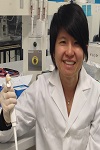Day 1 :
Keynote Forum
Marcos Ascensión
Spanish National Research Council (CSIC). Spain
Keynote: The impact of overweight and obesity on adolescence: consequences on metabolic biomarkers
Time : 09:00-09:25

Biography:
Prof. Marcos got her PhD at the School of Pharmacy at the Complutense University in Madrid, Spain (UCM) in 1982 and Master in Clinical Analysis by UCM in 1986 and got a grant at the Spanish National Research Council (CSIC) and she was the Head of the Institute of Nutrition and Food Technology at the Mixed Center CSIC-UCM (1998-2002). She is the leader of the Immunonutrition Research Group at the Department of Metabolism and Nutrition at CSIC since 1987. Prof. Marcos achieved the highest category at CSIC as a Research Professor in 2006 and her scientific consolidation has been recognized for 5 six-year terms since 1985. She is a pioneer in the field of Immunonutrition in Spain, Founder and President of the International Forum of Immunonutrition for Education and Research (i-FINER) since 2007. In 2014 the i-FINER group has developed the International Society for Immunonutrition (ISIN), Dr. Marcos being also the President
Abstract:
important risk to suffer from inflammation related pathologies, such as type 2 diabetes, coronary artery disease, atherosclerosis, hypertension, and very frequently infections and allergies. In addition, there are several confounder factors, such as age, gender, eating behaviour, physical activity, sedentariness and sleep that are essential to take into account in order to implement successful treatments and achieve the best results. The increase in childhood obesity has been reported to lead to adult associated comorbidities that give rise to elevated healthcare costs. Therefore, treating obesity in young people is critical to prevent adult obesity-related complications. However, as adolescence is characterized by important changes in body size and composition, it is important to highlight that weight management treatments for obese adolescents should aim to ensure adequate growth and development, by reducing excessive fat mass accumulation, avoiding loss of lean body mass, improving well-being and self-esteem and preventing cyclical weight regain. During treatments a follow-up of biomarkers evaluation is essential to assess changes in the metabolism. Among them, very recently during the last decade, the gut microbiota composition has been shown up as a potential partaker in the development of obesity and its association with the subsequent insulin resistance. In summary, obesity prevention in early ages and the evaluation of biomarkers acquire a great interest to promote life quality through preventing inflammatory mechanisms along life.
Keynote Forum
Ali H. Mokdad
University of Washington, USA
Keynote: Global Burden of Disease, injuries, and risk factors in 188 countries, 1990-2013
Time : 09:25-09:50

Biography:
Ali Mokdad, PhD, is Director of Middle Eastern Initiatives and Professor of Global Health at the Institute for Health Metrics and Evaluation at the University of Washington. He started his career at the US Centers for Disease Control and Prevention (CDC) in 1990. He has published more than 300 articles and numerous reports and received several awards, including the Global Health Achievement Award for his work in Banda Aceh after the tsunami, the Department of Health and Human Services Honor Award for his work on flu monitoring, and the Shepard Award for outstanding scientific contribution to public health
Abstract:
The Global Burden of Disease 2013 (GBD) is a systematic, scientific effort to quantify the comparative magnitude of health loss from all major diseases, injuries, and risk factors by age, sex, and population and over time for 188 countries from 1990 to present. It covers 306 diseases and injuries, 2,337 sequelae, and 76 risk factors. GBD provides Years of life lost due to premature mortality (YLLs), Years lived with disability (YLDs), and Disability-adjusted life years (DALYs). Global life expectancy for both sexes increased from 65.3 years in 1990, to 71.5 years in 2013, while the number of deaths increased from 47.5 million to 54.9 million over the same interval. For women aged 25–39 years and older than 75 years and for men aged 20–49 years and 65 years and older. YLDs for both sexes increased from 537.6 million in 1990 to 764.8 million in 2013, while the age-standardized rate decreased from 114.87 to 110.31 per 1,000 people between 1990 and 2013. The aggregation of the 14 specific components of diet accounts for nearly one tenth of global DALYs in 2013. After diet, high systolic blood pressure is the next most important global risk factor accounting for 8.5% of all DALYs up from 5.6% in 1990. It is the underlying causes of diseases and injuries that ought to guide prevention efforts, and knowing their comparative magnitude, and trends, in causing health loss is arguably among the most important information required by countries to prioritize health programs and policies
Keynote Forum
Homayoon Farzadegan
Johns Hopkins Bloomberg School of Public Health, USA
Keynote: Critical role of large scale academic repositories in epidemiology and public health
Time : 09:50-10:15

Biography:
Homayoon Farzadegan, PhD, professor of Epidemiology at the Bloomberg School of Public Health. A native of Iran, he first came to the United States in 1969 to complete his graduate studies, then taught at Tehran University School of Medicine. He immigrated to the United States in 1980, following the Iranian revolution in 1979, and became a U.S. citizen 18 years ago. His research interests include infectious diseases, viral diseases transmitted by blood and other body fluids, epidemiology and natural history studies, and genetic epidemiology. Farzadegan abilities to engage students—sometimes under less-than-ideal conditions earned him the Golden Apple, as the teaching award is known at the School, in the best small class category. In 2003, 2007, 2008, 2009 Golden Apple Award for excellence in teaching.
Abstract:
Sequentially obtained biological samples stored at optimal frozen condition provide a powerful tool in epidemiological studies to address the role of biomarkers in epidemiology and public health. Cryogenically maintained sequentially collected specimens from participants of cohort studies or epigenetic studies are successfully used in non-concurrent prospective studies to determine and evaluate predictive values of potential biomarkers. At Johns Hopkins School of Public Health, 2.5 million blood samples were collected and stored at specific time intervals to address natural history of infectious diseases, potential gene-environment correlations in disease progression. The Johns Hopkins Biological Repository (JHBR) included more than 30 cohort studies of infectious disease or epigenetics of diseases on unknown etiology. Important biomarkers such as HIV-1 viral load as predictor of progression to AIDS or effectiveness of antiretroviral treatment were discovered. Using frozen specimen collected in multicenter cohort studies (MACS) or the study of HIV among IDU’s collected since 1984-1988 were utilized to address the side-effects of HIV treatment as well as chronic disease among HIV survivors. COPD gene studies including 10,000 participants and Autism genetic studies including hundreds of parents and Autistic children utilized frozen DNA to study the genetic association with these diseases. Examples of data from these studies will be presented describing technical, structural the functional aspects of cryogenic facilities, frozen specimen and study designs in epidemiological studies.
Keynote Forum
Sophia Salenius
Reg Point S.L, Spain
Keynote: Daily Medical Support (DMS)
Time : 10:35-11:00

Biography:
Sophia Salenius is Managing Director of RegPoint Ltd, a health services company supplying wireless technology to the global healthcare community. She is a leading expert in the international IT healthcare field and a sought after guest speaker at professional conferences around the world. Ms. Salenius is well known as the inventor behind the unique mHealth solution for public health threat detection and management called RegPoint. Her invention is also used in a wireless early warning and advice solution for natural disasters such as earthquakes, tsunamis and hurricanes, as well as to combat public health threats including chronic diseases and epidemics such as SARS and the Avian A flu.
Abstract:
Two significant aspects of the management of a epidemics, pandemics and chronic diseases are ensuring that patients comply with their prescribed treatment and close monitoring of symptoms of the public. Providing medical practitioners, epidemiologists and disease controlers and patients with a mechanism that encourages treatment compliance and provides the means to monitor symptoms in real or near-real time would not only facilitate better management of diseases, but would also reduce the costs related to the diseases and reduce the spread of them. Such a mechanism is made available through the Daily Medical Support (DMS) standard for communication that makes use of the RegPoint software module, a wireless disease management system operating via mobile telephony. The concept, developed by the health services company RegPoint Ltd (www.RegPoint.eu), is specially designed to monitor all kind of diseases.
Keynote Forum
Cecaro Massimo
Italian Medical Press, Italy
Keynote: Massi-care: innovative method to communicate emerging diseases in an easy way
Time : 11:00-11:25

Biography:
Dr Massimo Cecaro achieved a Master Degree in Veterinary Medicine and Specialization in the field of Public Health and Preventive Medicine. He worked as radio speaker, TV presenter and reporter for a wide range of artistic and scientific events. At the age of 24 he obtained a qualification to practice as a Journalist and in 2007 he was admitted to the National Association of Medical Press (ASMI), where he currently holds the position of National Councilor. He is Resident Member of MJA Medical Journalists’ Association (London). He has been invited as Keynote speaker, mentor, chairman, Honourable Guest at International events in the field of Public Health and Safety in Canada, USA, Europe and Asia. He is also director in Italy of a prestigious Educational Centre for work safety and public health. He is actively involved in International projects to improve the role of mass-media in medical sciences, and awarded in Philadelphia, Valencia and Las Vegas with International special recognitions. He is serving as an editorial member of several reputed journals, and Editor-in-Chief in the “Occupational Medicine & Health Affairs” and in “Journal of Mass Communication & Journalism”. He is Founding Editor in Chief of “Journal of Occupational Health & Research”. He is OCM of several International Conferences in US and in Europe.
Abstract:
An important role in preventing the infectious diseases comes from competent journalist that should have the right knowledge of medical sciences. The “One Medicine Approach” is the result of the co-participation between medical doctors (MD and DVM) and the scientific community (biologist, and expert in this field) with the support of journalists that should have a proven experience in the field of the infectious diseases, and more in general, on scientific subjects. We should create a new model to deliver information that should give clear news in a simple way and with correct methodology aiming to express “final information” without any alarmism. In fact on newspapers we sometime read about scenario that could spread to media the sense of panic or that are not precisely “politically correct” with an enormous, catastrophic, impact on our society; we should instead deliver the information that it is actually important to give avoiding “just the dissemination of results to the public’. The new model MASSI-Care (Model of Acquire Scientific Specific Information on Care) would be to be a sort of method that could deliver correct information - epurated by “non-scientific surrounding” - in a proper, rigorous, way. An ideal checklist should incorporate the basic principles of medical science reporting with the journalist’s code of ethics. (Cecaro 2012)
- Session 1
- session 2
Session Introduction
Chia-chi
University of Sydney, Australia
Title: Oxidative inhibition of erythrocyte sodium pump: a functionally relevant circulating marker of oxidative stress

Biography:
Dr Chia-chi Liu is a Research Fellow at the University of Sydney. She majored in Cell and Molecular Biology at Taipei Medical University, Taiwan; obtained her second master degree in Biotechnology at University of New South Wales; and received a PhD in Chemistry and Bio-molecular Science from Macquarie University in 2007. Dr Liu’s core focus is investigating the relationship between oxidative stress and the sodium pump function. Her research interests include the development of new diagnostic methods for oxidative damage of the pump; the discovery of new drugs for heart disease; and the design of novel therapeutic proteins for cancer treatment. Dr Liu has awarded a Australian National Heart Foundation Post-Doctoral Fellowship and Sydney University Research Support Fellowship; and is the inventor for an innovative Australian patent in diagnostic technology
Abstract:
Oxidative stress plays critical roles in the pathogenesis of diabetes and heart disease. The activity of Na pump has been shown to be depressed from the membrane of erythrocyte preparations of these patients coupled with alterations in membrane protein composition. We had previously discovered that the ï¢1 subunit of the Na pump undergoes oxidative modification by oxidative stress in vitro (ï¢1-GSS) and this mediates Na pump inhibition. This study aims to develop and validate erythrocyte ï¢1-GSS as an oxidative stress biomarker in the premier emerging tool for prognosis of pathophysiological oxidative stress in patients with or at risk of cardiovascular disease (CVD) and diabetes. The marker is quickly and easily tested from blood using ELISA; and could be packaged and marketed as a simple kit. The eï¢1-GSS biomarker is modified in heart attack, heart failure and diabetes, and exhibits potential to predict disease progression. With further investment, the eï¢1-GSS biomarker could be developed initially as a versatile CVD prognosis tool for universal pre-hospital diagnostics, CVD-severity risk-stratification, and as a Companion Diagnostic (Dx) for CVD medications. Subsequently it could be adapted for diabetes.
Ashraf Elmetwally
King Saud bin Abdulaziz University Saudi Arabia
Title: The Epidemiology of Congenital Heart Disease in Saudi Arabia: A Systematic Review

Biography:
Ashraf El-Metwally is a medical doctor with a PhD in Epidemiology and Biostatistics (University of Tampere, Finland). He joined the College of Public health and Health Informatics in August 201, while holding an honorary lecturer position at the department of Public Health- University of Aberdeen in the UK. Dr. El-Metwally research interests are in the epidemiology of pain, musculoskeletal disorders and rheumatic diseases, with 15 published research papers and reports in international peer-reviewed journals. His international awards include the Young Investigator Award from the British Society of Rheumatology (2006), First Prize for The Best Submitted Paper and Presentation from the British Pain Society (2007).
Abstract:
Several studies have been conducted on CHD in different regions of Saudi Arabia. However, no recent systematic review has examined the growing scientific evidence with respect to the epidemiology of CHD in the Kingdom. The aim of this review is to provide a comprehensive summary of CHD incidence, prevalence, burden and impact on the Saudi population. A literature search was conducted in PubMed and Google Scholar using relevant keywords to identify studies performed in Saudi Arabia regarding CHD from 1993 up to December 2013. Articles that were in English that described or investigated the epidemiology, etiology, distribution, impact and burden of CHD in the Saudi Arabian population were included. 21 articles met these criteria. Cross-sectional studies found the prevalence of CHD ranging between 2.1 to 10.7 per 1,000 persons. The most prevalent type of CHD was the ventricular septal defect ranging from 29.5% to 39.5% of all diagnosed CHDs, followed by atrial septal defect (8.9% to 18.1%) and pulmonary stenosis (6% to 12.4%). Overall, the incidence of severe CHD was approximately 5.4 per 1,000 live births per year. Occurrence of CHD in Saudi Arabia was significantly associated with Down ’s syndrome, consanguinity and maternal diabetes. Studies on the burden of these anomalies on children, families and society are scarce. This systematic review found that prevalence of CHD is comparable to that in other developing countries. Several modifiable risk factors have been identified emphasizing the importance of public health programs that are aimed at tackling such potentially preventable risk determinants.

Biography:
Abstract:
Saudi community is a population that is characterized by sudden economic and social changes, leading to a sharp increase in the prevalence of diabetes mellitus (DM) and abnormal glucose metabolism. Thus, the present research review had the objective to evaluate epidemiology of DM among Saudi community since 1980. Materials and Methods: Having extensively explored Saudi and International databases (SDL, PubMed, Google Scholar, Medline, web of science, Science Direct, Scopus, and WHO) with broad keywords, we looked for relevant papers about frequency of diabetes mellitus among Saudi population since 1980. We recruited only those primary papers with required information and acceptable methodology by reviewing their titles, abstracts, and full-texts. Pertinent was identified by searching databases, the main data about the prevalence of diabetes, age and sex distribution of subjects, sample size, date, and location of studies were extracted from the full-text of eligible papers. Results: A total of 20 valid articles were identified and selected for analysis. All those articles were cross-sectional descriptive studies. Out of the total, only 7 (35 %) were nationwide. Among the findings of these studies, the lowest diabetes prevalence was 2.5 % amongst 1387 males surveyed in Al-Kharj area in 1982, and highest prevalence was 30 % was present in 1792 (30%) patients surveyed attending a primary care clinic in June 2009. The vast majority of studies reviewed indicate that the prevalence of diabetes was increasing with age among Saudi community and it was more prevalent among males in comparison with females. The research findings indicate that the prevalence of diabetes has increased by 10 to 12-folds over the past four decades among Saudi community. Conclusion: The prevalence of diabetes appears higher among Saudi community than in other developing countries. This condition is a major public health significance in Saudi Arabia causing a considerable challenge for all health care providers and the foundation of health care system in the country. Efforts should be concerted to combat the increasing incidence of DM.
Alaa Al haeli
King Saud bin Abdulaziz University, Saudi Arabia
Title: The Epidemiology of Dengue fever in Saudi Arabia: A Systematic Review
Biography:
Ashraf El-Metwally is a medical doctor with a PhD in Epidemiology and Biostatistics (University of Tampere, Finland). He joined the College of Public health and Health Informatics in August 201, while holding an honorary lecturer position at the department of Public Health- University of Aberdeen in the UK. His research interests are in the epidemiology of pain, musculoskeletal disorders and rheumatic diseases, with 15 published research papers and reports in international peer-reviewed journals. His international awards include the Young Investigator Award from the British Society of Rheumatology (2006), First Prize for The Best Submitted Paper and Presentation from the British Pain Society (2007).
Abstract:
Abstract Dengue fever (DF) is the most serious mosquito-borne viral disease worldwide. It is an acute febrile illness caused by AedesAegypti mosquito bite. It is endemic in some cities of Saudi Arabia such as Jeddah and Makkah. A computer-based literature search was conducted using relevant keywords to retrieve studies conducted in Saudi Arabia pertaining to DF. Forty-five articles were identified initially. After screening for exclusion and retrieving full texts, a total of ten articles were used for this review. Four studies were cross-sectional and three found a sero-prevalence ranging from 31.7% to 56.9% either among clinically suspected cases or among patients visiting hospital for other reason. Evidence extracted from risk factors and distribution studies showed that young males are commonly affected. Fever, vomiting, thrombocytopenia and leucopoenia were the common features of the three studies related to clinical presentation of DF. One cross-sectional study about educational program of DF showed a positive family history of DF, having literate mothers, and students’ age ≥17 were the predictors of high knowledge score. However, paucity of population-based studies limits generalisability of such evidence. Future studies in Saudi Arabia should focus upon extending DF on other cities in the Kingdom and more population based epidemiological studies are needed for estimating the true burden and incidence of dengue in Saudi population, as currently there are few epidemiological studies about dengue and are only limited to sero-prevalence among clinically suspected cases and among hospital based patients.
- session 3
Session Introduction
Samantha Iyaloo
National Institute for Communicable Diseases (NICD), South Africa
Title: Staphylococcus aureus bacteremia: risk factors associated with death

Biography:
Abstract:
Background: Staphylococcus aureus bacteremia (SAB), especially when caused by methicillin-resistant S. aureus (MRSA), is associated with increased patient morbidity, death and increased healthcare costs. Modifiable risk factors for death are important to identify and incorporate into interventions to reduce the burden of illness. This study aimed to describe the risk factors associated with death among patients with MRSA vs. methicillin-sensitive S. aureus (MSSA) bacteremia. Methods: We undertook a retrospective study of patients admitted to three hospitals in Gauteng province, South Africa, from September 2012-July 2014. Patients with SAB were recruited through active, enhanced, laboratory-based surveillance. Demographic, clinical and laboratory data were collected by face-to-face interviews, chart and laboratory record reviews using standardized case report forms. Statistical analysis was conducted using STATA 13. Survival analysis was performed using univariate and multivariate Cox proportional hazards regression analysis and Kaplan-Meier (KM) survival curves to compare MRSA and MSSA risk factors for death. Results: During the 23-month period, a total of 589 cases of SAB were detected with an overall case-fatality rate of 30.2% (178/589). The adjusted KM survival curves showed a higher mortality rate in patients with MRSA vs. MSSA. The incidence for MRSA vs. MSSA-associated deaths was 23.3 and 12.9 deaths per 1000 patient-days respectively from the collection date of the first positive specimen. Increasing age (OR: 1.02, 95%CI: 1.01-1.03), diabetes mellitus (OR: 3.18, 95%CI: 1.19-8.53), a history of smoking (OR: 6.06 95%CI: 1.32-5.06) and any antibiotic use within two months preceding admission (OR: 2.62, 95%CI: 1.36-5.06) were risk factors for death in the multivariate Cox model in the MRSA sub-group. HIV infection (OR: 2.60, 85%CI: 1.24-5.44), cerebrovascular accidents (OR: 3.76, 95% CI: 1.20-11.78) and fever (OR: 0.60, 95% CI: 0.37-0.97) were associated with deaths in the MSSA sub-group in the multivariate Cox model. Conclusions: The incidence and the risk factors for death in patients with MRSA and MSSA were remarkably different. Identification of predictors for death among patients with MRSA and MSSA bacteremia can help prioritize the management of these patients.
Inam Danish Khan
Command Hospital (EC), Kolkata, India.
Title: EMERGING ORGANISMS IN A TERTIARY HEALTHCARE SET UP IN NEW DELHI, INDIA

Biography:
Dr Inam Danish Khan is an alumnus of the Armed Forces Medical College and Army Hospital Research and Referral. He is a specialist in Clinical Microbiology and Infectious Diseases at a premier Indian Armed Forces Hospital. His additional research interests include Military and Mountain Medicine. He has published 02 book chapters and 15 papers in journals of repute, and has received 02 research awards.
Abstract:
BACKGROUND Emerging organisms are organisms that have newly appeared in a cohort/population or have existed but are rapidly increasing in incidence, geographic or host range. Recently discovered etiological agents of known diseases are also considered as emerging organisms. One tenth of all infectious diseases are attributable to emerging organisms. However, operationally defining an organism as emerging is a subjective endeavor. As emerging organisms sporadically affect a relatively small percentage of population they are not studied at large. OBJECTIVES This study was aimed at studying the frequency, sources, resistance and susceptibility profiles, and phenotypic characteristics of emerging organisms encountered at an apex tertiary care teaching and research hospital in New Delhi, India. METHODS 16918 positive isolates obtained from 66323 culture samples were included. Both manual and automated systems were used for identification and antimicrobial susceptibility. Sources of isolates, referring centers and drug resistance were noted. A literature search was done to identify reports on human pathogenicity. CONCLUSION Out of 16918 isolates, 13498 (79.78%, 95% confidence interval is 79.17% to 80.39%) were Gram negative bacteria, 3254 (19.23%, 95% CI 18.64% – 19.83%) Gram positive bacteria and 166 (0.98%, 95% confidence interval is 0.83% – 1.13%) were yeasts. A total of 122 (0.72%, 95% CI is 0.59% – 0.85%) emerging organisms were identified comprising 56 genera. Emerging organisms are likely to evade routine identification or be disregarded as non-contributory. Astute efforts directed at identification of emerging isolates, decisions by clinical microbiologists and treating physicians and containment of infection are required.
- session 4
Session Introduction
Jiazhi Zeng
Sun Yat-sen University, P. R. China.
Title: Overtime work and depression among female migrant workers in Guangzhou, China: a cross-sectional study

Biography:
Jiazhi Zeng is a Masters Student in Faculty of Medical Statistics and Epidemiology, School of Public Health, Sun Yat-sen University, China. Her research field during her postgraduate study is occupational health of migrant workers. She is also a research assistant (part-time) of Sun Yat-sen Center for Migrant Health Policy, China. She will participate in the Inaugural International Conference on Migration, Social Disadvantage and Health for poster presentation in Feb 11-13, 2015, Melbourne, Australia and participate in the 31st International Congress on Occupational Health for oral presentation in May 31- June 5, 2015, Seoul, Korea.
Abstract:
China is facing the unprecedented challenges of rapidly increasing rural-to-urban migrant workers. Several studies revealed that depression was associated with unemployment, bad living conditions, discrimination and social inequity among migrants. However, few studies have examined the association between working hours and depression among them. This study aims to explore whether overtime work is associated with depression among female migrant workers in Guangzhou, China. This was a cross-sectional survey of 1003 rural-to-urban female migrant workers in Guangzhou, China in 2013. An anonymous, self-administered questionnaire was used for data collection. Depression was assessed by the 20-item Center for Epidemiologic Studies Depression (CES-D) Scale. Multiple logistic regression model was adopted to assess the association between overtime work and depression. 280 (28.0%) participants had depressive symptoms (CES-D scores ≥16 points). Female migrant workers working 45~65h/week had significantly lower risk of depression compared to those working <45h/week (OR = 0.58, 95%CI 0.39-0.87), and the OR for depression was 2.10 (95%CI 1.25-3.18) times higher for those working >65h/week than for those working <45h/week, when adjusted for socio-demographic characteristics, migrant characteristics, work-related characteristics and lifestyle factors. Heavy overtime work is associated with an increased risk of depression, meanwhile, those reported working less than 45h/week, who are likely to have job uncertainty and low income, are at higher risk of depression compared with those working moderate overtime. These findings are interesting from a health promotion perspective, female migrant workers working <45h and >65h/week predispose to depression and need preventive action against depression.
Verpaele Steven
Adhesia vzw, Belgium
Title: A Comparison of Samplers for Inhalable Welding Fumes and Laboratory Analysis for Manganese

Biography:
Abstract:
Welding fumes are a major domain of interests among occupational hygienist. Sampling these fumes demand great skill of the occupational hygienist, with important considerations such as the use of samplers, filters, sampling time and laboratory analysis. This study focused on the differences that may occur while sampling and analyzing welding fumes. The comparisons were done by using the Workplace Atmosphere Multisampler (WAM). The device was earlier validated for the comparison of respirable dust, but could also be validated for inhalable welding fumes (5,5% average variation) in this study. At the same time, the necessity of the use of a simplified torso for inhalable dust sampler comparisons was evaluated. The study shows that the use of a simplified torso was unnecessary to use in the selected workplace conditions (calm air conditions), since the variation between the WAM and the Torso was not more than 4,9%. Mixed Cellulose Esters filters (MCE) were used as reference filters and compared to polycarbonate (PC), polyvinylchloride (PVC) and glass fiber filters (GF). Gravimetric analysis found that the MCE filters were under sampling, compared to the PVC (y = 0.88x), the PC (y = 0.82x) and the GF (y = 0.91x), while there were no significant differences found in between the other types of filters. The IOM conductive plastic sampler was tested against the IOM stainless steel sampler, and no significant differences were found between the two types of samplers. Three different laboratories performed the analysis of manganese on the different filters by using there own in-house method. The analyzing techniques used where Inductive Coupled Plasma (ICP)-Mass Spectroscopy (MS) and Atomic Absorption Spectroscopy (AAS). For the manganese percentage in the gravimetric determined welding fume the same approach was used to compare the differences. Manganese analysis found that the MCE filters were equally sampling compared to the PVC (y = 1.02x) and the GF (1,06) and is slightly oversampling compared to the the PC (y = 1.13x). Compared with the gravimetric analysis it seems that MCE filters retain more Manganese than the other filters tested in this study.
- Track: Approaches to Health Security and Emergency Response
Track: From Data to Policy: Changing life style and global non-communicable diseases prevention strategies
Track: Environmental Epidemiology and The Impact on Public Health Practice
Track: Recent Advances in Occupational Health
Track: Psychiatric Epidemiology

Chair
Marcos Ascensión
Spanish National Research Council (CSIC). Spain

Co-Chair
Gary J. Macfarlane
University of Aberdeen, United Kingdom
Session Introduction
Chia-chi Liu
University of Sydney, Australia
Title: Oxidative inhibition of erythrocyte sodium pump: A functionally relevant circulating marker of oxidative stress
Time : 11:30-11:50

Biography:
Chia-chi Liu is a Research Fellow at the University of Sydney. She majored in Cell and Molecular Biology at Taipei Medical University, Taiwan. She obtained her second Master degree in Biotechnology at University of New South Wales; and received a PhD in Chemistry and Bio-molecular Science from Macquarie University in 2007. Her core focus is investigating the relationship between oxidative stress and the sodium pump function. Her research interests include the development of new diagnostic methods for oxidative damage of the pump; the discovery of new drugs for heart disease; and the design of novel therapeutic proteins for cancer treatment. She has been awarded an Australian National Heart Foundation Post-Doctoral Fellowship and Sydney University Research Support Fellowship; and is the inventor for an innovative Australian patent in diagnostic technology.
Abstract:
Oxidative stress plays critical roles in the pathogenesis of diabetes and heart disease. The activity of Na pump has been shown to be depressed from the membrane of erythrocyte preparations of these patients coupled with alterations in membrane protein composition. We had previously discovered that the ï¢1 subunit of the Na pump undergoes oxidative modification by oxidative stress in vitro (ï¢1-GSS) and this mediates Na pump inhibition. This study aims to develop and validate erythrocyte ï¢1-GSS as an oxidative stress biomarker in the premier emerging tool for prognosis of pathophysiological oxidative stress in patients with or at risk of cardiovascular disease (CVD) and diabetes. The marker is quickly and easily tested from blood using ELISA; and could be packaged and marketed as a simple kit. The eï¢1-GSS biomarker is modified in heart attack, heart failure and diabetes, and exhibits potential to predict disease progression. With further investment, the eï¢1-GSS biomarker could be developed initially as a versatile CVD prognosis tool for universal pre-hospital diagnostics, CVD-severity risk-stratification, and as a Companion Diagnostic (Dx) for CVD medications. Subsequently it could be adapted for diabetes.
Teresa Chahine
Harvard University, USA
Title: Sociodemographic and geographic variability in environmental exposures and health risks: Implications for community-based public health
Time : 11:50-12:10

Biography:
Teresa Chahine completed her doctor of science degree at Harvard School of Public Health, Department of Environmental Health with an interdisciplinary concentration in gender and health. She is a research associate at the Center for Health and the Global Environment, Harvard University where she serves as the social entrepreneurship program lead. Dr. Chahine teaches Social Entreprenuership in Health and the Environment at Harvard T.H. Chan School of Public Health and Harvard University Extension School. Her new textbook “Introduction to Social Entrepreneurship†will be released by Taylor and Francis in 2016.
Abstract:
The research community has yet to fully characterize environmental health risk factors that are present in all communities and affect multiple health outcomes but cannot be described using national average statistics and risk estimates. In many cases, local data to inform risk prioritization is lacking. Although national databases and risk estimates are available for most environmental issues of concern, communities express concern that summary statistics are not enough to inform their local assessments. This raises a challenge for researchers: to synthesize information from national databases in a way that allows it to be disaggregated to elucidate patterns of high exposure and high risk in different populations and in different places. This paper provides examples from research conducted at Harvard University in collaboration with the United States Environmental Protection Agency. Implications are discussed for the role of non-governmental organizations such as community based organizations in gathering and assimilating data is likely to grow as community-based research develops in the future. Federal databases are limited to providing standardized data with often numerous restrictions. Local data collection is key, and while it is not always possible to synthesize local data at a national level due to differences in data collection measurements and techniques, it is recommended that organizations working on the ground with local communities to coordinate their efforts may have more opportunities to gather and coordinate local data at a large scale than federal agencies.
Yangfeng Wu
The George Institute for Global Health at Peking University Health Science Center, China
Title: Use of Salt Substitute to Reduce High Blood Pressure: Experiences from China
Time : 12:10-12:50

Biography:
After receiving his undergraduate and graduate training in medicine, public health, and epidemiology, Yangfeng Wu started his career as a research fellow in a US-PRC Collaborative Study of Cardiovascular and Cardiopulmonary Epidemiology at Cardiovascular Institute and Fu Wai Hospital, Chinese Academy of Medical Sciences. He has led many large scale national and international research projects and published over 200 peer-reviewed papers in Chinese and international journals. As a cardiovascular expert, Dr Wu has made valuable contributions to reducing the impact of cardiovascular disease in China, hence received many awards and honors from Chinese government, non-governmental agencies, and international academic communities.
Abstract:
Based on the knowledge that sodium intake is positively and potassium intake is negatively associated with blood pressure level, potassium enriched and sodium reduced salt substitute was developed to replace regular salt in order to lower blood pressure of the consumers through dietary approach. However, salt substitute has not been widely used in population although it has been on the market for several decades. This talk will review the evidences from randomized controlled trials on the efficacy of salt substitute in reducing blood pressure, peripheral and central, and pulse wave velocity as well as the cardiovascular mortality and total death. Data on its acceptability and possible adverse effects will also be reviewed. Besides, the talk will cover the effects of strategies that used salt substitute to reduce salt intake. Finally, suggestions will be made on potential policy implementations.
Maja Subelj
National Institute of Public Health of Slovenia, Slovenia
Title: Outbreak of influenza A (H3N2) in a residence for mentally disabled persons in Ljubljana, Slovenia, 2013
Time : 12:30-12:50

Biography:
Maja Subelj With background as a Medical Doctor and completed PhD Interdisciplinary Biomedical Doctoral Study at the University of Ljubljana I presently work as a Public Health Specialist at the National Institute of Public Health of Slovenia. I am included in the infectious diseases surveillance, response to public health threats, public health training, and hospital acquired infections control. In my present post, I build on the knowledge and experience in the communication and cooperation with general and professional public at the local, regional and national level, including publications in scientific journals.
Abstract:
Background: In January 2013, a residence for mentally disabled persons reported a suspected outbreak of influenza. We carried out an outbreak investigation to describe the outbreak and to recommend control measures. Methods: We conducted descriptive epidemiology of the outbreak; a case was a resident or staff of the residence for mentally disabled with fever (≥38◦C) and cough and/or sore throat between 25 and 29 January 2013. Specimens were tested for respiratory pathogens, including influenza viruses.Control measures were taken to contain the infection. Results: A total of 13 persons presented with influenza–like illness symptoms, the aetiology proved influenza A (H3N2) virus. Twopersons were hospitalized due to severe pneumonia. The overall attack rate was 17%. The first cases were among staff. The residents were ill at the peak of the outbreak, and among staff the presentation was more dispersed. None of the staff and only five of the residents had been vaccinated. Conclusions: Staff possibly have initiated and contributed to the maintenance of transmission. We highlight the need to comply with vaccination recommendations, especially for staff working with persons with risk factors.
Mathilde Knight
The George Washington University, USA.
Title: The impact of global warming and snail susceptibility to schistosomiasis
Time : 13:30-13:50

Biography:
I have worked on schistosomiasis related research since 1982 and during this period have worked on molecular aspects of the causative schistosome parasite, Schistosomamansoni, as well as the intermediate snail host, Biomphalariaglabrata. In the parasite, the focus of my research was identifying antigens of the larval schistosomula and adult worm stages for vaccine development. In the snail host, my laboratory initiated studies that successfully described genetic variations between parasite resistant and susceptible snails. These investigations led to the first publication showing heritability of markers for the schistosome refractory phenotype in B. glabrata. My lab, in collaboration with the then TIGR institute, also initiated studies that made use of cDNA libraries generated from a variety of tissues (hemocytes, hepatopancreas, albumen gland, ovotestis, cerebral ganglia) to assess differences in transcriptomic profiles between resistant and susceptible snails. Work in my lab recently led to the discovery that early stress induction culminating in the expression heat shock proteins, such as Hsp 70 and 90 in juvenile snails is a significant aspect of snail susceptibility to S. mansoni. In collaboration with Dr Joanna Bridger at Brunel University, UK we were also the first to discover spatial epigenetics in the snail host schistosome relationship. My current research interest in the Brindley lab at the George Washington University is to develop transgenesis technology in the B. glabrata embryonic (BGE) cell line, enabling us to dissect mechanisms that can be disrupted to block the parasite’s development in the snail host.
Abstract:
Schistosomiasis a major Neglected Tropical Disease (NTDs) that remains difficult to control. Its recent reemergence in Corsica, France confirms its spread from Africa to higher latitudes. Freshwater snails are obligate hosts for development of asexual stages of the trematode that causes schistosomiasis in the tropics and subtropics. Lately, it has been reported that a Mass Drug (praziquantel) Administration (MDA) approach alone to control schistosomiasis has had little impact in curtailing transmission in endemic countries. Without a vaccine to prevent schistosomiasis and this realization that drugs alone will not deliver the global eradication of schistosomiasis, there is impetus for alternative methods to control schistosomiasis, focusing on blocking transmission in the snail. Towards this end, we adopted a molecular approach to identify mechanism(s) that underlie the snail/schistosome interaction. By using resistant and susceptible Biomphalaria glabrata snails infected with Schistosoma mansoni, differences in early gene expression in genetically resistant (BS90) and susceptible (NMRI) snails were investigated. Several genes were differentially expressed between the snail phenotypes. Among others, the stress genes encoding Hsp70 and Hsp 90 were significantly expressed in NMRI (susceptible) compared to the BS90 resistant snails. Intriguingly, snails that was resistant at room temperature when subjected to heat shock at 32oC for 3hours were rendered susceptible. Moreover, the Hsp90 inhibitor geldenamycin rendered susceptible NMRI snails as resistant as BS90. The implications of these data within the context of global warming and the snail vector approach to reduce schistosomiasis will be discussed.
Ahmad Mohammed Ashshi
Umm Al-Qura University, Saudi Arabia
Title: Serodetection of dengue virus and anti-dengue antibodies among blood donors in the western region of Saudi Arabia
Time : 13:50-14:10

Biography:
Ahmad Mohammed Ashshi is dean, Faculty of Applied medical Sciences at Umm Al Qura University, Kingdom of Saudi Arabia.
Abstract:
Dengue is the most important mosquito-borne viral disease with an estimated 100 million infected cases and 25,000 deaths per year worldwide. It is caused by Dengue virus (DENV), which is a single-stranded RNA virus with five serotypes (DENV-1, DENV-2, DENV-3, DENV-4 and DENV-5). Transfusion safety is of paramount importance to the recipient of blood products. In recent decades, the safety of blood products with regards to the risk of HIV, HBV and HCV infections has increased dramatically; however, emerging infectious diseases still pose new threats and risks to the safety of blood products and transfusions. In this concept, a special attention has recently been paid to the significant role of blood transfusion in the transmission of DENV and/or its antibodies from asymptomatic infected blood donors to recipients. Given the absence of an approved blood screening test for DENV in Saudi Arabia and in response to the new epidemiological situation, the current study was designed to determine the seroprevalence of DENV infection and/or its antibodies among Saudi blood donors. In this study, healthy adult male Saudi blood donors, negative for HIV, HCV and HBV infections and accepted according to the KSA\'s blood donation policy, were screened for DENV-NS1 antigen and IgM and IgG anti-DENV antibodies. The results showed that among the tested donors, 1% showed positivity for DENV-NS1 antigen, 6% were positive for anti-DENV IgM antibody and 7% were positive for anti-DENV IgG antibody. This study provides the first data on seropositivity for DENV and its antibodies among Saudi Arabian blood donors and highlights the importance of establishing quantitative or molecular serological methods for screening for DENV and/or its antibodies inblood donors, so that the quality of blood transfusions is guaranteed and the endemicity of DENV is reduced.
Brian I. O’Toole
University of Sydney Brain & Mind Research Institute, Australia
Title: Secondary Effects of War Service: The Families of Australian Vietnam Veterans
Time : 14:10-14:50

Biography:
Brian holds a BSc in Mathematics, PhD in Psychology, and MPH in Epidemiology. He has been researching psychological effects of trauma for 25 years with domestic violence victims, child sexual assault victims, and combat veterans. He conducted the first ever epidemiological study of any returned Australian veterans, and has extended this to a three-decade follow-up, with the veterans and their families. He has been a board member of the Vietnam Veterans Counselling Service over 18 years, and has taught epidemiology and statistical analysis at Sydney, Queensland and NSW Universities, and has published more than 150 papers and government reports.
Abstract:
When combat soldiers return home, they carry the legacy of combat and posttraumatic stress disorder into their post-war lives. An epidemiological cohort study of 1,000 Australian veterans of the Vietnam War has examined the associations of combat trauma exposure on the physical and mental health of the veterans and their wives and partners three decades after the war, using standardised combat assessments and WHO/CIDI psychiatric interviews. Veteran combat is strongly associated with alcohol use disorders, domestic violence, posttraumatic stress disorder, depression and other psychiatric disorders in the veterans, and with anxiety and depression, suicidality and marital dysfunction in their wives. The cohort has now included 315 veterans’ adult children to examine any “ripple effects†in combatants’ children. This paper will present the first findings for the association of veteran combat and PTSD on the mental health of their adult offspring, using the same standardised psychiatric interviews. Results include that veterans’ depression, PTSD and combat are associated with offspring PTSD [OR (95%CI) for PTSD diagnosis = 2.25 (1.10, 4.75)]; veteran alcohol dependence is associated with offspring reports of father’s interpersonal violence [OR (95%CI) = 8.30 (2.52, 27.35) and offspring PTSD [OR (95%CI) = 2.49 (1.07, 5.80), and veteran PTSD is associated with offspring substance dependence [OR (95%CI) = 2.98 (1.21, 7.34)]. The fighting currently occurring around the world may carry with it higher post-conflict public health risks of psychiatric disorders not only in the fighters but also in their families.
Gabriele Messina
University of Siena, Italy
Title: Environmental contaminants in hospital settings and progress in disinfecting techniques
Time : 14:30-14:50

Biography:
Gabriele Messina MD Dr.Ph MSc Epidemiology graduated in 1999 at the University of Siena, in 2002 obtained the Master in Epidemiology (London School of Hygiene and Tropical Medicine) and in 2003 had the Degree of Specialist in Hygiene and Public Health at the University of Siena. From 2005 he is Research Professor of Hygiene and Public Health in the University of Siena. He published more than 90 scientific full papers.
Abstract:
Background: Medical devices, such as stethoscopes (ST), and other objects, such as computers keyboards (CK) and telephones handsets (TH) in the hospital, may represent reservoirs of bacteria, possibly determining health-care associated infections (HAIs). Aims of the study were to evaluate microbial contamination of ST, CK and TH pre/post use of a disinfecting technique (DT) and the contamination differences in 4 different units. Materials: We conducted a cross-over study, involving 4 wards of an Italian hospital. We evaluated before/after use of DT the total bacterial count (TBC) at 36°C and 22°C, and several species individually. We analysed 37 TH, 27 CK and 35 ST and compared the contamination between them and 4 hospital wards. Wilcoxon signed-rank and Mann-Whitney tests were used. Results: Before cleaning we found positive samples for Staphylococcus spp. (60% for ST, 83% for TH and 93% for CK), coliforms (43% for ST, 59% for TH and 78% for CK). We also detected some positive samples for MRSA. After DT, the CFUs decreased to zero in most comparisons. First aid ward had the highest contaminations level, while Intensive care the lowest one, with significant difference (P<0.01). CK and TH were significantly more contaminated than ST for TBC at 22°C(P=0.046) and for molds(P=0.002). Conclusion: Objects used during the exercise of clinical professions are source of bacterial contamination. Health care professionals need to be sensitized to disinfect not only stethoscopes but also many objects of common use. Some units, such as first aid, where patients’ turnover is high, should adhere a stricter rules of disinfection.
Dominique Jeannel
WHO& French Institute for Public Health Surveillance, France
Title: Why persistence of Ebola community deaths in Conakry, Guinea?
Time : 14:50-15:10

Biography:
Dr Dominique Jeannel is Head of regional office in French Institute for Public Health Surveillance at France.
Abstract:
Early February 2015, while Ebola cases decreased markedly since December 2014, the number of Ebola community deaths (ECD) in Conakry showed no decrease, although all Ebola riposte activities were deployed. A study was then conducted on ECD trends, history of contamination and disease, seeking for health care and social reaction. Trends in Ebola cases, deaths in Ebola clinics and in community, and statistics of calls to the Ebola free hotline in Conakry (N°115) were analyzed. For all ECD between 1st January and 12 February 2015, a descriptive analysis was conducted from investigation reports. The number of ECD remained stable at 5/week since week 50 2014. During the study period, the number of calls to N°115 ranged 880-1100/week, with 8% concerning ECD. Twenty seven ECD were reported, with 78% biologically confirmed and 74% with safe and dignified burials; 89% of the deceased were unidentified contacts, 78% were Conakry residents. At least 37% were infected in Conakry and 44% in areas of active transmission in low Guinea region, where reticence/hostility to Ebola control activities were reported; 49% attended unsafe funerals. The source of transmission was outside Conakry for at least 71%. Disease duration ranged 3-13 days (peak 7 days); 59% sought for health care, mainly in private medical clinics, and in national hospitals for 3. Reticence/hostility to Ebola control activities was reported in 44%. This study showed that ECD in Conakry early 2015 originated mainly from helping Ebola patients or during funeral attendance in places of active transmission in low Guinea. Gaining population cooperation appeared as a major factor for the success of Ebola control in Guinea. The high proportion of these Ebola deceased in community who sought for healthcare raised the importance of triage reinforcement in clinics and hospitals.
Roberto Antonio Flores
National University of Santiago del Estero , Argentina
Title: Impact on Chest Trauma UTI
Time : 15:10-15:30

Biography:
Dr. Roberto Antonio Flores has been graduated from National University of Tucuman, Argentina as Medical Doctor, with the specialties including Internal Medicine, Social and Community Medicine and Diploma in Cardiology from the National University of Tucuman and Medical Clinic National Academy of Medicine Argentina. Later on he obtained his post-graduation from National University of Cuyo with subjects Pharmacology & Biology and then started working at The Nurses School, Faculty of Humanities, Social Sciences and Health, National University of Santiago del Estero, Argentina where he has continued his research. Presently he has been working at the Regional Hospital Dr. Ramon Carrillo, Santiago del Estero City. He has got eminent memberships in many Scientific Societies including Internal Medicine and Cardiology at the Society of Santiago del Estero, Argentina, Membership of Argentina Federation of Cardiology, Membership of Hypertension Committee of Argentina Federation of Cardiology, Membership of Inter American Society of Cardiology and Board of Epidemiology of Inter American Society of Cardiology.
Abstract:
Introduction: Traumatic injuries are the leading cause of death in the first four decades of life. It is estimated that one in four deaths from trauma corresponds to a rib injury. 70-80% of them are usually secondary to blunt and vehicular collision. Nearly two thirds are associated with other injuries, preferably head injuries, or abdominal trauma, which increases its complexity and priority both in establishing procedures and diagnostic and treatment. OBJECTIVES: 1. Characterize the population admitted to ICU Versatile and chest trauma. 2. Analyze the evolution of patients with single thoracic trauma that occurs with trauma associated. MATERIALS AND METHODS: A quantitative, descriptive, and cross-sectional. It was performed from March 2008 to December 2011 (28 months). The medical records of 149 patients admitted to Intensive Care Unit Multipurpose Adults (UTIA) with chest trauma, period analyzed. Variables analyzed: sex, age, signs of alcohol intoxication to causes different type of injury, single chest trauma or associated with other injuries, ventilation, complications, mortality. Statistical analysis: Mean and percentages as summary measures for qualitative variables. RESULTS: Of 149 patients with thoracic trauma admitted to UTIA, 25 were women (16.78%) and 124 men (83.22%) with a mean ISS average age of 29.03 and 33.46 years. Among the causes were found: vehicular collision falls and stab wounds and fire. Many cases associated with probably signs of alcohol intoxication (ethyl encouragement and rescue SNG). Pulmonary contusion accounted for 53.02% (n = 79), with a mortality rate of 48.10% (n = 38). The 95.97% (n = 143) had associated trauma (Trauma skull, abdomen, pelvis, long bones, vascular, spinal cord injuries), the highest percentage Trauma Brain Injury (TBI) in 78.52% (n = 117). The mortality of the population analyzed with Thoracic Trauma was 31.54% (n = 47), all with associated trauma (100%). TEC high impact on mortality with 72.34% (n = 34) was demonstrated. The most frequent infectious complications were directly related to the length of hospitalization. CONCLUSION: The mortality of thoracic trauma in UTIA was higher in patients with associated trauma (especially with TEC) and vehicular collision. Most were young men with signs of alcoholic intoxication income. The most common thoracic injury was pulmonary contusion. Patients with single chest trauma had a better prognosis and no deaths. Moto vehicular collision is the leading cause of death at an early age in our province so it remains of aramount importance to emphasize primary prevention measures. We consider policies to prevent and reduce trauma for this cause should focus on education, applying reasonable standards and monitoring compliance.
Verpaele Steven
Adhesia VZW ,Belgium
Title: A Comparison of Samplers for Inhalable Welding Fumes and Laboratory Analysis for Manganese
Time : 15:50-16:10

Biography:
Steven Verpaele is President at Belgian Center for Occupational Hygiene – BeCOH, Belgium
Abstract:
Welding fumes are a major domain of interests among occupational hygienist. Sampling these fumes demand great skill of the occupational hygienist, with important considerations such as the use of samplers, filters, sampling time and laboratory analysis. This study focused on the differences that may occur while sampling and analyzing welding fumes. The comparisons were done by using the Workplace Atmosphere Multisampler (WAM). The device was earlier validated for the comparison of respirable dust, but could also be validated for inhalable welding fumes (5,5% average variation) in this study. At the same time, the necessity of the use of a simplified torso for inhalable dust sampler comparisons was evaluated. The study shows that the use of a simplified torso was unnecessary to use in the selected workplace conditions (calm air conditions), since the variation between the WAM and the Torso was not more than 4,9%. Mixed Cellulose Esters filters (MCE) were used as reference filters and compared to polycarbonate (PC), polyvinylchloride (PVC) and glass fiber filters (GF). Gravimetric analysis found that the MCE filters were under sampling, compared to the PVC (y = 0.88x), the PC (y = 0.82x) and the GF (y = 0.91x), while there were no significant differences found in between the other types of filters. The IOM conductive plastic sampler was tested against the IOM stainless steel sampler, and no significant differences were found between the two types of samplers. Three different laboratories performed the analysis of manganese on the different filters by using their own in-house method. The analyzing techniques used where Inductive Coupled Plasma (ICP)-Mass Spectroscopy (MS) and Atomic Absorption Spectroscopy (AAS). For the manganese percentage in the gravimetric determined welding fume the same approach was used to compare the differences. Manganese analysis found that the MCE filters were equally sampling compared to the PVC (y = 1.02x) and the GF (1,06) and is slightly oversampling compared to the the PC (y = 1.13x). Compared with the gravimetric analysis it seems that MCE filters retain more Manganese than the other filters tested in this study.
Govindasamy Ravivarman
Chettinad University, India.
Title: An Integrated Comprehensive Global Surveillance Strategy to mitigate Global Emergence and Reemergence of viral Infections.
Time : 16:10-16:30

Biography:
Presently working as Director & Professor of Community medicine, Chettinad University, India, for teaching PG and UG medical students in Public Health, Epidemiology and guiding research projects. Qualified MD, DPH, DPM, MBBS, under TN Medical University. Consultancy and Research work with UNICEF (IMNCI), AIIMS, Delhi. Consultancy and Health Management services for DANIDA (RCH), WORLD BANK (ICDS III project), also worked as Addl. Director of Public Health, Consultant and Technical Advisor for AIDS control programs. Published research articles in various national and International Journals. Member of INCLEN and Honorable Secretary for INDIA CLINICAL EPIDEMIOLOGIAL NETWORK, Member of Indian Public Health Association.
Abstract:
The Global emergence and reemergence of viral infections and new cycles of pandemics necessitated the global health surveillance so important and have received unprecedented recognition. This article proposes, “An Integrated Comprehensive Global Surveillance Strategy “to address the issues and challenges of Global Health by strengthening Surveillance system at multistage levels from local to Global. 1) Up gradation of International Health Regulations, WHO’s eHealth systems, smart phone technology, Global Outbreak Alert and Response Network and Research are becoming essential internationally. 2) At Regional level, the neighboring countries which are organizing surveillance worldwide at their source, to control cross-border outbreaks, need to be expanded to nearby countries and linked toWHO. 3) At the national level, the critical gaps in the implementation of IDSR guidelines to be revised and reshaped for the collection, dissemination, and interventions, for epidemic response. The immunization programs, drug resistance surveillance, Research are also to be integrated with global surveillance. 4) At the State/local level, Integrating Epidemiological networks, the Private practitioners networks, Govt. surveillance Networks, cross border surveillance networks, Eco-health, Veterinary public health surveillance network and the data related to screening of travelers, mortality, climate, lab are needed for Research . 5) Capacity building in field epidemiology, assessing social determinants, host, vector, pathogen interactions and mapping of disease hot spots are required to predict, prevent and control the global level outbreaks. Diversity and complexity of global health, creating an integrated infrastructure of Surveillance and Research are biggest challenges, but WHO, developed nations, donor agencies support needed to overcome this. Key words: Integrated Global surveillance, Strategy for Global Health, Epidemiological approach to viral Infections.
Donald M Lyall
University of Glasgow, UK
Title: Low birth weight and risk of neuroticism and mood disorder in 83,545 participants of the UK Biobank cohort
Time : 16:30-16:50

Biography:
Donald M Lyall is a Research Associate in Epidemiology at the Institute for Lifelong Health and Wellbeing, University of Glasgow. He completed his PhD at the University of Edinburgh, supervised by Prof. Ian Deary, Prof. David Porteous, and Prof. Joanna Wardlaw, and has previously worked as a Postdoctoral Research Fellow in cognitive neuroscience at the National Institute on Aging, NIH, Baltimore USA, and as an Assistant Clinical Psychologist at NHS Greater Glasgow and Clyde. His main research interests are in Epidemiology, Dementia, Neuroscience and Psychiatric disorders.
Abstract:
Background: Low birth weight has been inconsistently associated with risk of developing affective disorders, including major depressive disorder (MDD). To date, studies investigating possible associations between birth weight and bipolar disorder (BD), or personality traits known to predispose to affective disorders - such as neuroticism - have not been conducted in large cohorts. In the UK Biobank cohort, we assessed whether low or very-low birth weight (1,500 g-2,490 g and <1,500 g, respectively) were associated with higher neuroticism scores in middle age, and/or lifetime history of either MDD or BD. Methods: We controlled for possible confounding factors including year of birth, gender, maternal smoking and depression, ethnicity, socioeconomic status, and also potentially mediating physical disorders such as hypertension, in 83,545 participants with relevant data. Results: Referent to normal birth weight, very-low/low birth weight were associated with higher neuroticism scores (b range = 0.21-0.31 inventory points), increased MDD in unadjusted and adjusted analyses (relative risk ratio range = 1.05 to 1.32), and BD (relative risk ratio range = 1.10 to 1.74). The associations between birth weight category and MDD were partially mediated by higher neuroticism. Conclusion: Low/very-low birth weight was significantly associated with neuroticism, MDD and BD in adulthood, with evidence of a dose effect across low and very-low birth weight. These findings suggest that intra-uterine programming may play a role in lifetime vulnerability to affective disorders.
Sandra Milena Agudelo-Londono
Pontificia Universidad Javeriana, Colombia
Title: Why Diagnosis related groups are not welcome in Colombia?
Time : 16:50-17:10

Biography:
Sandra Agudelo is a Health information system Manager and has a Master in Epidemiology from Universidad de Antioquia in Colombia. She is proffesor of Health information systems and Managerial Epidemiology in Pontificia Universidad Javeriana, Bogotá. She has published several papers in reputed journals and has been serving as member of the editorial board of Gerencia y PolÃticas de Salud Journal in her country.
Abstract:
Diagnosis Related Groups (DRGs) are a electronic patient classification system that allows hospital homogenize the product to compare the performance of specialists care, reduce the variability of medical practice, improve clinical management and make transparent the payment system. DRGs are used in many countries and would be useful for the Colombian Health system. However, attempts to introduce DRGs in Colombia were unsuccessful. Only eight of fifty high complexity hospitals have DRGs, which makes it an innovation. The existing literature is abundant in the use of DRGs, but is scarce on the reasons for accepting or rejecting DRGs in hospitals. The aim of our study was to explore the determinants for non-implementation of DRGs in hospitals in Colombia. We use a qualitative case study approach to analyze the perceptions of the directors of six hospitals with and without DRGs in Bogota. The theory of diffusion of innovation was the theoretical basis of the interview applied. It was found that the directors had similar perceptions of the determinants. Although DRGs are perceived as positive, obstacles to implement it were found in two levels: organizational (threats to physician autonomy, culture of non conflict, poor diagnostic coding and emphasis on processes rather than results) and institutional (imperfect health market, negotiation between insurers and providers based on procedures not on diagnoses and finally lack of public policies pro DRGs). It was concluded that unless there is a public policy that leverages the issue, the possibility of DRGs in Colombia is not in the near future. Los Grupos Relacionados de Diagnóstico (GRD) son un sistema de clasificación de pacientes que permite homogeneizar el producto hospitalario para comparar el desempeño de los especialistas, reducir la variabilidad de la práctica médica, mejorar la gestión clÃnica y hacer transparente el sistema de pagos. Los GRD se utilizan en muchos paÃses y serÃan útiles para el Sistema General de Seguridad Social en Salud de Colombia. Sin embargo, los intentos de introducir GRD en Colombia fueron infructuosos. Solo ocho de cincuenta hospitales de alta complejidad tienen GRD, que los convierte una innovación para el paÃs. La teorÃa de difusión de innovación sugiere que la adopción de una innovación depende de sus atributos: ventaja, compatibilidad, complejidad, capacidad de prueba y observabilidad. La literatura existente, abundante en cuanto al uso de los GRD, es escasa sobre los motivos para aceptar o rechazar GRD en hospitales. El objetivo de nuestro estudio fue explorar los determinantes para la no implementación de los GRD en hospitales en Colombia. Enfoque cualitativo de estudio de casos, para analizar las percepciones de los directores de seis hospitales con y sin GRD en Bogotá. La teorÃa de difusión de la innovación fue el fundamento teórico de la entrevista aplicada. Se encontró que los directores tuvieron percepciones similares frente a los determinantes. Aunque los GRD se percibieron como positivos, se encontraron obstáculos para implementarlos a nivel organizacional (amenaza a la autonomÃa del médico, cultura del no conflicto, mala codificación diagnóstica y énfasis en procesos en vez de resultados) e institucional (competencia imperfecta en salud, negociación entre aseguradoras y proveedores basada en procedimientos no en diagnósticos y finalmente, falta de polÃticas públicas pro GRD). Estos hallazgos son únicos en su tipo en el mundo, debido a la particularidad del sistema de salud colombiano. Se concluyó que a no ser que haya una polÃtica pública que apalanque el tema, la posibilidad de GRD en Colombia no se ve en el futuro cercano.
- Track: Human Sexual Behavior and Reproductive Health
Track: Approaches to Health Security and Emergency Response
Track: From Data to Policy: Changing life style and global non-communicable diseases prevention strategies
Track: Environmental Epidemiology and The Impact on Public Health Practice

Chair
Diana Anderson
University of Bradford, United Kingdom

Co-Chair
Sophia Salenius
RegPoint S.L, Spain
Session Introduction
Paul A Levy
University of Maryland, USA
Title: Examining the Social and Physical Environment of Adolescent Substance Users in Shanghai and East Baltimore
Time : 14:35-14:50

Biography:
Paul is currently working as a research assistant at the American Institutes for Research (AIR) supporting projects surrounding Youth Violence Prevention in major US cities and the “Safe Schools / Healthy Students†initiative, focused on positive behavioural interventions, school violence prevention, and healthy childhood development throughout adolescence. Paul graduated in December 2013 from the BCH program and has been able to build upon many of the lessons learned from his experience within the program. Most recently he attended the APHA conference in New Orleans to assist in the presentation on the Youth Violence grant initiative and his contributions in his summer internship at the Bloomberg School of Public Health has led to a publication this December in the Journal of Adolescent Health. Paul looks forward to continuing his work at AIR as well as narrowing down his focus and applying to graduate schools in “Environmental Health†in the near future. Despite graduating, his continual mentorship from professors within BCH, including James Butler, Kerry Green, and Muhiuddin Haider have contributed immensely in motivating Paul to seek out diverse and challenging opportunities.
Abstract:
Adolescent substance use is a problem that has affected communities across the globe. Research has shown that the social and physical environments play a tremendous role in its prevalence within society. This study aims to look at communities within Baltimore and Shanghai to examine how social factors such as friend and teacher support as well as the infrastructure of a community neighbourhood contribute to adolescent cigarette, marijuana, and alcohol use. Utilizing a respondent driven sampling strategy, researchers surveyed 455 participants from Shanghai and 472 participants from Baltimore between the ages of 15-19. Indicators such as gender, school status, and work status were held constant to ensure no other variable was a significant contributor. Using linear regressions while controlling for gender, school status, and work status, researchers found an association between current marijuana use and ever cigarette use and increased teacher support within Baltimore. In Shanghai, the association was between ever cigarette use and ever alcohol use and teacher support. Friend support was not associated with substance use habits in either site. Increased perception of community cohesion was associated with ever cigarette use in Shanghai along with in-school status. Lastly, an increased perception of community cohesion was associated with lower marijuana use and alcohol use in Baltimore. Teacher support was the most influential variable showcasing the significance education may play in combating substance use. These findings suggest that future research should be conducted at how environmental and social factors can be enhanced in urban communities to improve adolescent substance use.
Shireen Samargandy
King Abdulaziz University, Saudi Arabia
Title: Epidemiology and clinical consequences of occupational exposure to blood and other body fluids in a University Hospital in Saudi Arabia
Time : 17:10-17:25

Biography:
Shireen Samargandy is a senior medical student at King Abdulaziz University, Faculty of Medicine. She has an interest in clinical research and infection control.
Abstract:
Objective: To describe the epidemiological characteristics, clinical impact, and adequacy of post-exposure management of occupational exposures to blood and other body fluids (BBFs) at King Abdulaziz University Hospital, Saudi Arabia. Design: Retrospective review study over 7 years. Participants: Individuals reporting BBFs exposures from 2006 to 2012 were identified from Infection Control and Environmental Health unit. Methods: Charts of exposed individuals were reviewed to collect relevant data using a standardized data collection form. Results: The total number of exposures reported was 326 exposures, of which 302 (92.6%) exposures were percutaneous, 21 (6.5%), mucocutaneous, and 3 (0.9%), bites. Nursing staff/students had the highest rate of exposure (149, or 45.6%), followed by physicians (57, or 17.5%), and dental students (39, or 12%). Surgeons had a higher risk for sharp injuries compared to other physicians (p<0.005). Most (216, or 72.5%) percutaneous injuries were caused by hollow-bore needles. The majority of exposures (124, or 42.6%) occurred after use of the needle/sharp and before disposal. The source patient was known to be positive for HBV, HCV, or HIV in 72 (22.1%) incidents, negative for all three viruses in 147 (45.1%), negative for one or two viruses and unknown for others in 13 (3.9%) and unknown/untested for all three in 94 (28.8%). Two-thirds (219, or 67%) of exposed individuals were immune to hepatitis B at the time of exposure, and none seroconverted to HIV, HBV, or HCV infection. Conclusion: Occupational exposure to BBFs is concerning among healthcare workers. Educational programs targeting high-risk groups entailing preventive measures and post-exposure management are needed.
Alexandra Vatsiou
University Joseph Fourier, France
Title: Pathways and genes under positive selection in metabolic diseases
Time : 16:55-17:10

Biography:
Alexandra Vatsiou at the age of 24 years old is in her final year of PhD undertaken in the University Joseph Fourier in Grenoble. Her PhD is a Marie Curie program and the University Joseph Fourier is in collaboration with Era7, a Bioinformatic company in Granada, Spain and the Scottish Oceans Institute in the University of St Andrews. She completed her bachelor degree in University of Thessaly in Greece and her Master of research degree (MRes) in Computational Biology in the University of York where she was awarded with a BBSRC scholarship.
Abstract:
Uncovering signatures of positive selection has been a long-standing interest in the field of genomics. The high prevalence of metabolic diseases such as diabetes has been suggested to be associated with positive selective pressures. Advantageous alleles increase in frequency and linked surrounding deleterious mutations rise in frequency as well, therefore the high prevalence of many diseases. High-density SNP maps of the human genome enable us to look for such regions involved in the susceptibility to diseases, particularly diabetes, obesity and metabolic syndrome. Firstly, we conduct a sensitivity analysis to evaluate the performance of several existing methods to detect positive selection. Out of the 7 methods (EHHST, XPEHHST, XP-EHH, iHS, nSL, XPCLR and hapFLK) that were compared under various demographic scenarios, XPCLR and iHS were found to perform best. These two methods were used for a genome scan of the HapMap Phase II database. Based on these results, we carried out an enrichment analysis to uncover signals enriched for positive selection. Two methods to conduct the enrichment analysis were used: the SUMSTAT statistic and Gowinda, an already available tool. String, Intact and Bio4j databases were also used to extract information about possible Protein-Protein Interactions associated with the ‘interesting genes’. Our results indicate that selection has affected in a large percentage the evolution of diseases in the human history. More specifically, 64 pathways were discovered to have undergone selection and a total of 16 positively selected genes were found to have a direct or indirect links with diabetes, obesity or metabolic syndrome.
Isac da Silva Ferreira Lima
University of Brasilia, Brazil
Title: Factors related with early treatment for malaria in the Brazilian Amazon: A multivariable approach using a ten-year population-based malaria surveillance database
Time : 16:40-16:55

Biography:
Isac da Silva Ferreira Lima’s research interest is focused on applications of biostatistical and epidemiological methods to epidemiology research. He obtained his BSc degree in Statistics from University of Brasilia in 2005 and completed his MSc in Epidemiology from University of Alberta, Canada in 2010. His worked on many different projects and have collaborated with researchers in Brazil, Canada and USA. In particular, he has provided statistical support to a major group of researchers involved in the Childhood Cancer Survivor Study (CCSS), and on another two projects with the Alberta Health Services and the Alberta Ingenuity Centre for Machine Learning (AICML) which led to two research publications. He is currently a PhD student in Epidemiology at the University of Brasilia working under the supervision of Dr. Elisabeth Carmen Duarte. His thesis work is focused on the application of multivariable techniques for the investigation of factors associated with incidence, mortality and early treatment for malaria in the Brazilian Amazon.
Abstract:
Background & Aim: Despite all the efforts to reduce malaria incidence and to prevent deaths, the disease persists as an important public health problem in the Brazilian Amazon. Malaria is a treatable disease and essentially all deaths can be prevented throughout effective health care. Early malaria diagnostic and adequate treatment are not only a way to prevent deaths, but also an important tool for disease control in a population since it reduces the probability of mosquito bites in an infectedpatient. Consequently, the Malaria National Program (MNP) in Brazil has established as a strategic goal to decrease the delay between onset of symptoms and malaria treatment initiation. Therefore, it is important to investigate factors associated with late treatment initiation for malaria in the Brazilian Amazon to monitor the achievement of such goal. Materials & Methods: A population-based malaria surveillance database was obtained from the MNP-Ministry of Health for the period between 2004 and 2013. A multivariable adjusted logistic regression was fitted considering as outcome the lag time between onset of symptoms and treatment initiation (within 24 hours). Statistical significance was set at 0.05. Results: Over the 10-year study period, 3.3 million new cases of malaria were reportedto the MNP. Cases were mainly males (62%) and aged less than 40 years (82%). Nearly 41% of cases started malaria treatment within 24 hours of onset of symptoms. Cases receiving early treatment were at higher odds of being:i) identified in the field by active surveillance [adjusted odds ratio (AOR)=1.37; 95%CI: 1.35 - 1.39] compared to passive surveillance; aged less than 6 years(AOR=1.39; 95% CI: 1.34 - 1.44)and between 6-14 years-old (AOR=1.34; 95% CI: 1.32 - 1.36) compared to aged 30-59 years; diagnosed in 2012 (AOR=1.48; 95%CI: 1.42 - 1.54) and 2013 (AOR=1.42; 95%CI: 1.35 - 1.49) compared to cases diagnosed in 2004; from the states of Acre, Rondôniaor Roraima (AOR>1.20; p<0.05) compared to cases from the state of Pará; native population (AOR=1.43; 95% CI: 1.34 - 1.54) compared to white population; and illiterate population or with less than 4 years of formal education (AOR=1.39; 95% CI: 1.34 - 1.44) compared to population with incomplete high school or more years of education. Analysis was replicated using exclusively data from the year of 2013, and results were very similar. Conclusion: Early treatment for malaria appears to be associated with active surveillance, early ages, geographical areas and access to public health care facilities. Additionally, in recent years, cases were more likely to start treatment before 24hours since the symptoms onset. This result may indicate improvements on exam and treatment access lately in Brazil.
Uduakobong E Ntuk
University of Glasgow, UK
Title: Ethnic variation in the contribution of cardiorespiratory fitness and muscular strength to diabetes: Cross-sectional study of 68,116 UK Biobank participants
Time : 16:25-16:40

Biography:
Uduakobong E Ntuk is public health doctoral student at University of Glasgow, UK
Abstract:
Aims/Hypothesis: Diabetes prevalence is substantially higher in black and south Asian compared with white European adults. This study aimed to quantify the extent to which ethnic differences in cardiorespiratory fitness and muscular strength might account for this. Methods: This cross-sectional study used baseline data from UK Biobank on 68,011 white European, black and south Asian adults, aged 40-69 years, who had complete data on diabetes status, hand-grip strength and cardiorespiratory fitness. Associations between age and sex-specific textiles of fitness and strength (low, moderate, high) and diabetes were assessed in analyses adjusted for age, smoking, socioeconomic status and percentage body fat. Attributable risk associated with low-to-moderate fitness and strength was calculated for each ethnicity/sex group. Results: Diabetes risk was higher in blacks and south Asians than whites across almost all strength and fitness categories. Within each ethnicity/sex group, those with both low fitness and strength had 2.1-3.6 fold increased odds of diabetes compared with those with high fitness and strength. Attributable risk for diabetes associated with low-to-moderate strength and fitness was 8.2 and 5.0 cases per 100 people in south Asian men and women, respectively; 4.1 and 4.3 cases in black men and women; and 1.4 and 1.0 cases in white men and women. Conclusions/Interpretation: Low-to-moderate fitness and strength contributes to a disproportionately large number of diabetes cases in south Asian and black groups. Interventions to improve strength and fitness may help reduce ethnic inequalities in diabetes prevalence.
Xia Zou
Sun Yat-sen University, China
Title: Trends and risk factors of HIV, HCV, and syphilis seroconversion among drug users in methadone maintenance treatment program in China: A seven-year retrospective cohort study
Time : 15:50-16:05

Biography:
Xia Zou is student in Sun Yat-sen University, P.R. China
Abstract:
Among 9,240 participants, the overall HIV seroconversion rate was 0.20 (0.13-0.28)/100 person-years (pys), 20.54 (18.62-22.46)/100 pys for HCV, and 0.77 (0.62-0.93)/100 pys for syphilis over the study period. HIV seroconversion rate showed a moderate but non-significant annual decline of 13.34% (-42.48-30.56%) (Chi-2 trend test: p=0.369), whereas the decline of HCV seroconversion was 16.12% (5.53-25.52%) per annum (p<0.001). Syphilis seroconversionrate remained stable (p=0.540). Urine results positive for opioid predicted HIV seroconversion (≥60% versus <60%: HR=3.40, 1.07-10.85), being unmarried (HR=1.59, 1.15-2.20), injection drug use in the past 30 days (HR=2.17, 1.42-3.32), having sexual intercourse in the past 3 months (HR=1.74, 1.22-2.47) and higher daily dosage of methadone (≥60 ml versus <60 ml: HR=1.40, 1.01-1.94) predicted HCV seroconversion. Being female (HR=3.56, 2.25-5.64) and infected with HCV at baseline (HR=2.40, 1.38-8.36) were associated with subsequent syphilis seroconversion.
Farah Islam
University of Toronto, Canada
Title: Mental Health Consultation in Ontario’s Immigrant Populations
Time : 15:35-15:50

Biography:
Farah Islam, PhD, is a postdoctoral fellow in the Social Aetiology of Mental Illness (SAMI) program at the Centre for Addiction and Mental Health and the University of Toronto in Toronto, Canada. She completed her doctorate at York University (Toronto, Canada) in the field of epidemiology. She explores mental health and service access in Canada\'s racialized and immigrant populations, employing both quantitative epidemiology and mixed methods research. Farah orients her research and community work around breaking down the barriers of mental health stigma.
Abstract:
Introduction: Ontario is home to the largest immigrant population in Canada. The objective of this study was to determine the prevalence rates and characteristics of past-year mental health consultation for Ontario’s adult (18+ years old) immigrant populations. Methods: The Canadian Community Health Survey (CCHS) 2012 was used to calculate the prevalence rates of past-year mental health consultation by service provider type. To determine the characteristics associated with mental health consultation, multivariable logistic regression analysis was carried out on merged CCHS 2008-2012 data. Results: Adult immigrant populations in Ontario (n = 3,995) had lower estimated prevalence rates of mental health consultation across all service provider types compared to Canadian-born populations (n = 14,644). Amongst those who reported past-year mental health consultation, 57.89% of Ontario immigrants contacted their primary care physician, which was significantly higher than the proportion who consulted their family doctor from Canadian-born populations (45.31%). The factors of gender, age, racial/ethnic background, education level, working status, food insecurity status, self-perceived health status, smoking status, alcohol drinking status, years since immigration, and age at time of immigration were significantly associated with past-year mental health consultation for immigrant populations. Discussion: Ontario’s adult immigrant populations rely on their family doctor for mental health care. Potential exists for expanding community outreach for other avenues of mental health care. These findings provide an overview of mainstream mental health consultation. Comprehensive data to understand how immigrant populations attain informal and non-mainstream mental health care is needed. Examination of the social determinants of mental health is critical to understand how we can best serve the mental health needs of Ontario’s immigrant populations.
Yuan Ma
Peking University School of Public Health, China
Title: Salt sales survey: a simplified, cost-effective method to evaluate population salt reduction programmes-a cluster randomised trial
Time : 15:20-15:35

Biography:
Yuan Ma is a PhD student in Cardiovascular Epidemiology at Peking University School of Public Health. Her research interests lie in population salt reduction, diet & public health, and cardiovascular diseases. Her supervisor is Professor Yangfeng Wu. She is currently studying at Wolfson Institute of Preventive Medicine, Queen Mary University of London as an associate PhD student under the supervision of Professor Graham MacGregor and Dr. Feng He.
Abstract:
Background The 24h urine collection, as a gold standard method to measure salt intake, is costly and resource-consuming, hence limiting its use in monitoring population salt reduction programmes. Our study aimed to determine whether a salt sales survey could serve as an alternative. Methods We carried out a sub-study of China Rural Health Initiative Sodium Reduction Study (CRHI-SRS), where 120 villages were randomly allocated (1:1:2) to PS+HE (Price Subsidy + Health Education) intervention, HE (Health Education) intervention and control, with salt substitute(SS) supplied to shops in the intervention groups. 24h urine from 2567 randomly selected adults was collected at the end of the trial. In this sub-study, ten villages were randomly selected from each group (i.e. 30 villages in total) and 166 shops from these villages were invited for the monthly salt sales survey. Results The results showed that during the intervention period, mean daily sales of SS per shop were significantly different among three groups (PS+HE=1.3 kg> HE =0.6kg >control=0.1kg, all P<0.05). The pattern of differences was in line with that for 24h urine sodium and potassium. The intervention effect estimated from SS sales was 114% of that estimated from 24h urine for potassium and was 101% for sodium. Furthermore, the salt sales survey cost only 14% of that for 24h urine and had greater statistical power. Conclusions The results indicate that a salt sales survey could serve as a simple, sensitive and cost-effective method to evaluate community-based salt reduction programmes where salt is mainly added by the consumers.
Veerle Hermans
Médecins Sans Frontières, France
Title: Always two steps behind: Surveillance and chains of transmission during the Ebola outbreak in Bo, Sierra Leone, 2014
Time : 15:05-15:20

Biography:
Veerle Hermans completed an MSc in Biology in 2007 in Ghent, followed by a Postgraduate in Tropical Biomedical Sciences and International Health at the Institute of Tropical Medicine (ITM) in Antwerp. Staying as a scientific collaborator at the ITM she resulted in 2 published articles in Malaria Journal. A passion for primates motivated her to successfully complete a Master in Research on Primatology at Roehampton University in London in 2011. Between 2011 and 2013 periods of field work for the Max Planck Institute for Evolutionary Anthropology (Leipzig), she alternated with medical writing for Janssen Research and Development (Beerse). In April 2014, she started as a field epidemiologist for MSF Belgium, working in the Ebola response for 7 months in Sierra Leone and 2 months in Liberia.
Abstract:
Sierra Leone is the worst affected Ebola country housing almost half of all cases. Since April 2003 Médecins Sans Frontières (MSF) was managing a secondary level paediatric and obstetric emergency hospital near Bo Town, an economic hub in Sierra Leone. Close collaboration existed with the Ministry of Health Disease Surveillance Officers prior to the outbreak. When the first positive patient was confirmed in Bo, teams immediately started following up suspects and their contacts. Here we describe the mode of transmission over time, the different geographical clusters, and the breakdown in surveillance coverage in the district following the dramatic rise in case numbers. Program data were analyzed retrospectively from the 20th of June until the 18th of October 2014. A total of 288 suspects were investigated, with 161 confirmed and 61 probable cases. On July 4th of the 35 (11%) confirmed/probable patients were admitted to an MSF Ebola Treatment Centre, whereas in October this increased to 44% (24/55). Of all confirmed/probable cases, modes of transmission could be classified as funerals (37%), unknown (30%), house hold (16%), contacts without further information (5%), hospital acquired (9%) and contact while travelling/visiting family (3%). While in July, 11% of the confirmed/probable cases had an unknown mode of transmission, this increased to 58% in October. Although preparedness was started before the first case arrived in Bo District, the control over the situation was lost due to the magnitude of the outbreak and the shortage of human resources in the field to perform surveillance related activities.
Fangjing Zhou
Sun Yat-sen University School of Public Health, China
Title: Exploring the association between sexual risk behavior and social support in a population representative epidemiological study of Chinese adults in Guangzhou, China
Time : 14:50-15:05

Biography:
Fangjing Zhou is a postgraduate of Faculty of Medical Statistics and Epidemiology, School of Public Health, Sun Yat-sen University. She is an Assistant of Sun Yat-sen Center for Migrant Health Policy (CMHP), a multidisciplinary center on migrant health, which aims to pioneer knowledge on health of an important population with implications for national health policies and goals. The research teams of CMHP concentrate on primary health care, disease burden, mental health, sexual and reproductive health of migrants and so on. Her research direction is sexual health of migrants, focusing on sexual risk behavior and sexually transmitted disease. She has participated in related researches and a paper has been in peer review.
Abstract:
Background: Sexual risk behavior is highly sensitive and intimate within the Chinese cultural context, and is mainly assessed among high risk population, e.g. female sex worker (FSW), men who have sex with men (MSM) and rural-to-urban migrants. Megacities like Guangzhou have undergone evidently changes of population structure with increasing numbers of high-risk groups lacking social support. The importance of social support on sexual risk behavior is unclear. The current study, therefore, aims at investigating the association between sexual risk behavior and social support among Chinese adults. Method: Data was obtained from 765 Chinese adults aged 18-59 years using stratified random sampling by utilizing spatial epidemiological methods. Face-to-face interviews were conducted following randomization by building (nearest geographic coordinate) and floor levels, with participant selection based on lowest birthday method. Interviews were conducted in participants’ homes with a self-report questionnaire. Participants reported whether they had multiple sex partners or unprotected sexual behavior in the past month, respectively. Social support was measured by the Social Support Rating Scale scored 66 in total with 3 dimensions, namely subjective support, objective support and the utilization of support. Association between sexual risk behavior and social support was analyzed by univariate analysis followed by multivariate logistic regression analysis to adjust for possible confounding factors. Results: The prevalence of multiple sexual partners and unprotected sexual behavior was 18.25% and 52.51%, respectively. The average social support score was (38.08±8.20), subjective support score, objective support score and the utilization of support score were (21.41±5.78), (9.31±2.95) and (7.28±2.11). Those with lower score of subjective support were more likely to having multiple sexual partners (OR=0.901, [95%CI=0.847, 0.958]). Those with lower score of utilization of support were more likely to having unprotected sexual behavior (OR=0.844, [95%CI= 0.740, 0.962]). Conclusion: Evidence from this population-level survey indicates high exposure to sexual risk behavior and low social support in Guangzhou, whilst social support that is protective against sexual risk behavior. The role of social networks should be explored as potentially useful for community-based intervention development, especially among population with sexual risk behavior.
Audrey Steenbeek
Dalhousie University, Canada
Title: Predictors of pap screening rates among female university students in Maritime Canada
Time : 10:15-10:35

Biography:
Dr. Steenbeek is an Epidemiologist with expertise on Aboriginal sexual health, sexually transmitted infections, community based research and quantitative research methodology. Dr. Steenbeek received her PhD and Masters from UBC and her BScN from McMaster. She holds an active nursing practice at both the local ER department and in the north. Dr. Steenbeek has an appointment in Pediatrics at the IWK and is a member of the Health Policy & Knowledge Translation at the Canadian Centre of Vaccinology.
Abstract:
Background: In Canada, the human papillomavirus (HPV) is highly prevalent; approximately 75-80% of young adults will contract HPV, increasing risk for genital warts and cervical cancer. PAP screening is effective in detecting pre-cancerous cells (dysplasia), and despite its being free/available to most Canadian university students, many do not access it. Little is known about predictors of HPV screening among this population. Aims: Characterizing university students likely to be tested, to better promote PAP screening. Methods: Data comes from the Maritime Undergraduate Student Sexual Health Services Survey (2012), a cross-sectional, anonymous, online survey of Canadian undergraduate students at eight universities (n =10,361). This analysis focused on the sexual health of, and health services use by (n=4007) female students, weighted for demographics, imputed for missing values and limited to ages 19-29 (recommended screening age). We performed descriptive analysis and simple/multiple logistic regression analyses on factors associated with screening among vaginally sexually active females. Results: In unadjusted analyses, students at higher /moderate risk of HPV had significantly higher odds of ever having been screened than lower risk; 22% of sexually active females had never been screened. In multivariable models: those that were older, Caucasian, non-heterosexual, less religious, residing with a romantic partner, and those who had more sexual health knowledge and perceived their friends as having liberal attitudes had higher odds of ever having been tested. Those with more attitudinal barriers to help seeking were less likely to ever been tested. Perceived risk of HPV was not associated with testing. Conclusion Those at most risk of HPV were more likely ever tested, yet with 22% never tested it is unlikely that recommendations are being met. Efforts aimed at reducing barriers to help seeking and targeting residences may improve PAP screening in this population.
Gabriele Messina
University of Siena, Italy
Title: Use of a fluorescent marker for assessing hospital cleanliness
Time : 14:15-14:35

Biography:
Gabriele Messina MD Dr. Ph MSc Epidemiology graduated in 1999 at the University of Siena, in 2002 obtained the Master in Epidemiology (London School of Hygiene and Tropical Medicine) and in 2003 had the Degree of Specialist in Hygiene and Public Health at the University of Siena. From 2005 he is Research Professor of Hygiene and Public Health in the University of Siena. He published more than 90 scientific full papers.
Abstract:
Background: Hospital cleaning practices and methods for their assessment are important for healthcare-associated infections prevention. Aims of the study were: i) to assess the daily cleaning procedures of different surfaces in hospital bathrooms with a fluorescent marker, ii) to study correlations between results obtained by this method and microbial contamination. Methods: We enrolled 44 bathrooms of six hospital wards (A, B and C medical; D, E and F surgical) in which we analysed 218 surfaces (basin, toilet seat, flush button, inside door handle, light switch and floor). We applied a UV-fluorescent marker to these surfaces and the following day we assigned a score according how completely the marker had been removed. On the floor of each bathroom we also placed Petri dishes to assess bacterial colony forming units (CFU). The Wilcoxon test was used for comparisons between wards, Fisher’s exact test for removal scores comparisons between different objects, Spearman’s coefficient for correlations between CFU score and marker removal score. Results: Ward F proved to be less clean than wards A, B and E (p<0.05). Medical units were cleaner than surgical ones (p=0.0016). Basins were cleaner than the other surfaces (p<0.05), toilet seats were dirtier than floors (p=0.048) and door handles (p=0.013). CFU score and mark removal score did not seem to be correlated. Conclusions: The UV marker proved to be a practical and effective method for checking cleaning procedures. An early identification of inadequate cleaning practices allows the repetition of them until good hygiene standard are reached. UV marker could replace visual inspection, in a multistep process later including quantitative methods.
Misombo-Kalabela
Health Ministry, Democratic Republic of Congo
Title: Evaluation of the Tuberculosis surveillance system in the Lingwala Health District, province of Kinshasa / DRC, from 2008 to 2011
Time : 13:55-14:15

Biography:
Misombo-Kalabela A is officier in Provincial Health Office at Health Ministry of Democratic Republic of Congo.
Abstract:
Tuberculosis is a contagious disease which propagates by air. It is connected to poverty and affects especially productive young adults in developing countries. In 2009, Tuberculosis caused 1.7 million deaths. It is among the most three causes of death in women between 15 to 44 years old. The evaluation was based on the surveillance criteria of CDC / Atlanta. Informations were collected on a form for the period from 2008 to 2011. Health workers were interviewed using a questionnaire. We used excel software for analysis. On a total of 36 investigated health workers, 21 (58%) need less than 10 minutes to fill the notification form, 29 (80%) accept the surveillance as their daily work with 28 956 filled items on a total of 29 384; 88% (32/36) of reports are verified by another person. A place is planned for monitoring of other diseases on all notification forms. From 56 513 made samples 10 201 are positive. The surveillance system worked continuously during all the period of the study. Twelve health facilities from 28 (42. 8%) send their reports. The routine tuberculosis surveillance system in the Lingwala heath District is flexible, acceptable, and useful with a positive predictive value of 18 % as well as 87.5 % of validity and a weak representativeness of 42.8 %. It is integrated but presents the risk of distortion and lack of informations. It requires a strengthening of resources and the integration of private health facilities.
Veerle Msimang
National Institute for Communicable Diseases/NICD, South Africa
Title: Overview of emerging and detection of arboviral disease in South Africa
Time : 13:35-13:55

Biography:
Veerle Msimang is a bio-engineer, from Ghent University with a Master of Science in Veterinary Epidemiology and Public Health, from University of London Royal Veterinary College. She has worked on a number of animal production development and disease research projects in Singapore, South Africa, Ecuador and Madagascar. She is now epidemiologist for the Centre for Emerging and Zoonotic Diseases of the National Institute for Communicable Diseases in Johannesburg, South Africa, which she joined since 2007. She has authored and contributed to various publications in infectious disease epidemiology and is a growing expert in the epidemiology of zoonotic and vector-borne diseases.
Abstract:
The National Institute for Communicable Diseases in South Africa investigates humans for arboviral infections. Rift Valley fever/RVF virus, the most important remerging arbovirus, first appeared in 1951 but has persisted in wildlife reservoirs and floodwater mosquito vectors Aedes spp. ever since, resulting in irregular, unpredictable local emerging outbreaks throughout the country or large epidemics in central SA. The last epidemic of 2010-2011 resulted in 278 human confirmed cases and 25 deaths. West Nile/WN and Sindbis/SIN fever outbreaks commonly occurred simultaneously with RVF epidemics transmitted from birds by one of the same species mosquitoes used by RVF virus, i.e. Culex spp. e.g. 10% SIN detection rate in 2010. WN and SIN human infection on the central SA Highveld has been continuous but limited to sporadic cases annually e.g. 1.3% SIN detection rate (2006-2009). These viruses caused mainly fever with no mortalities or severe disease in humans in SA; although a fatal human WN case was reported in 2014. The evolution of Dengue/DEN and chikungunya/CHIK viruses into a form better adapted to human-to-human mosquito transmission is the principal cause of their emerging, and explosive spread into urban environments globally. DEN virus has not yet permanently established in an urban mosquito-human-mosquito cycle, neither exists in enzootic cycle in SA. Only a DEN outbreak occurred in Durban in the early 1900s. CHIK occurs in north-eastern parts of SA and few locally acquired cases/outbreaks are the result of accidental spill-over to humans. A concern is the growing urban CHIK and DEN (n=121, 2008-2014) imported cases.
Kevin Galalae
Center of Global Consciousness, Waterloo, Canada
Title: The subversion of medicine and public health by international security prerogatives
Time : 12:35-12:55

Biography:
Kevin Galalae is Founder of Center of Global Consciousness, Leader of Human Rights Party of Canada, and Chairman of Protect Your Child, in Ontario, Canada.
Abstract:
Medicine and public health have been gradually compromised by the highest echelons of science, industry and public administration, both nationally and internationally, for the geopolitical and geostrategic objectives of depopulation and decarbonization. Under the cover of reproductive health, involuntary and coerced sterilizations are carried out throughout the developing world through adulterated vaccines to bring the overpopulation problem under control, while in the developed world flu immunization programs serve to weaken the immune systems of the old and of civil servants to spare governments from meeting their already insolvent health care and pension plan obligations in the fourth and last stage of the demographic transition. Endocrine disruptors inserted in the basic elements of life – water, salt, milk, beverages, food, dental and cosmetic products – have been used, under the pretext of preventing caries and the spread of communicable diseases, since the early 1950s to chronically subvert the human reproductive system and bring down the total fertility rate of every country on earth to replacement level. In the name of sustainable development, experimental carbon capture and sequestration methods as well as solar radiation management methods double as weapons against human longevity throughout the developed world by subjecting billions of people to unnaturally high exposure levels of toxic heavy metals so the world’s decarbonization goals are tackled from two directions, by reducing greenhouse gases already in the atmosphere while at the same time increasing morbidity and mortality among the general population to proactively lower future emissions. Poverty and hunger are used as fronts for the deployment of genetically modified crops that purportedly increase yields, improve nutrition and require fewer fertilizers and pesticides, but that in fact misuse the latest bioengineering advances to cause subfertility, immune deficiencies and crop failures and thus lower the population by limiting births and increasing deaths. These chemical, biological and bacteriological methods are designed to weaken and confuse the autoimmune response of billions in preparation for naturally occurring pathogens or man-made pandemics, such as the current Ebola outbreak in West Africa, that are engineered when and if the UN and its agencies, aided by the military-industrial complex, decide to implement final solutions to prevent select regions of the world from losing control of society and to aid backward countries in reaching the Millennium Development Goals.
Tatiana V Macfarlane
University of Aberdeen, United Kingdom
Title: Aspirin use and risk of Head and Neck Cancer: evidence from the INHANCE consortium
Time : 12:15-12:35

Biography:
Dr Tatiana Macfarlane has completed her PhD in Epidemiology at the University of Manchester in England. She previously worked at the European Institute of Oncology in Italy and International Agency for Research of Cancer in France. Her main research interests are in epidemiology of head and neck cancer and oral health epidemiology. She has been involved in major international collaborations such as Alcohol-related Cancers and Genetic Susceptibility in Europe (ARCAGE) and International Head and Neck Cancer Epidemiology Consortium (INHANCE). She has published over 120 peer reviewed papers.
Abstract:
BACKGROUND: Aspirin and other non-steroidal anti-inflammatory drugs (NSAIDs) are widely used as analgesics and preventative agents for vascular events. Few studies have investigated the role of NSAIDs specifically for head and neck cancer (HNC), and the results are not consistent. AIM: The aim of this study was to examine the effect of aspirin on the risk of HNC within the International Head and Neck Cancer Epidemiology (INHANCE) Consortium (http://www.inhance.utah.edu). METHODS: Individual data were available from seven case-control studies conducted in ten countries (4372 cases and 7361 controls). Logistic regression with studies treated as random effects was used to estimate odds ratios (ORs) and 95% confidence intervals (CIs) adjusted for age, gender, education, smoking, alcohol consumption and body mass index. RESULTS: Prevalence of regular aspirin use (at least once a week for year) varied between studies (2% - 57%), and majority of participants (89%) used it for cardiovascular prevention. Regular aspirin use was associated with an overall risk reduction of HNC (OR 0.80, 95% CI 0.76, 0.85). Analysis by duration showed further reduction with long term use (10 years or more OR 0.75, 95% CI 0.62, 0.90; test for trend P=0.006). We found an inverse association for all sub-sites (OR 0.81, 95% CI 0.65, 1.00 for oropharynx, OR 0.38, 95% CI 0.26, 0.55 for hypopharynx and 0.75 95% CI 0.67, 0.85 for larynx) except oral cavity (OR 1.04 95% CI 0.89, 1.21).
Alaa Al haeli
King Saud bin Abdulaziz University, Saudi Arabia
Title: The epidemiology of dengue fever in Saudi Arabia: A systematic review
Time : 11:55-12:15

Biography:
Alaa AL haeli is a medical doctor with a PhD in Epidemiology and Biostatistics (University of Tampere, Finland). He joined the College of Public health and Health Informatics in August 201, while holding an honorary lecturer position at the department of Public Health- University of Aberdeen in the UK. His research interests are in the epidemiology of pain, musculoskeletal disorders and rheumatic diseases, with 15 published research papers and reports in international peer-reviewed journals. His international awards include the Young Investigator Award from the British Society of Rheumatology (2006), First Prize for The Best Submitted Paper and Presentation from the British Pain Society (2007).
Abstract:
Dengue fever (DF) is the most serious mosquito-borne viral disease worldwide. It is an acute febrile illness caused by AedesAegypti mosquito bite. It is endemic in some cities of Saudi Arabia such as Jeddah and Makkah. A computer-based literature search was conducted using relevant keywords to retrieve studies conducted in Saudi Arabia pertaining to DF. Forty-five articles were identified initially. After screening for exclusion and retrieving full texts, a total of ten articles were used for this review. Four studies were cross-sectional and three found a sero-prevalence ranging from 31.7% to 56.9% either among clinically suspected cases or among patients visiting hospital for other reason. Evidence extracted from risk factors and distribution studies showed that young males are commonly affected. Fever, vomiting, thrombocytopenia and leucopoenia were the common features of the three studies related to clinical presentation of DF. One cross-sectional study about educational program of DF showed a positive family history of DF, having literate mothers, and students’ age ≥17 were the predictors of high knowledge score. However, paucity of population-based studies limits generalisability of such evidence. Future studies in Saudi Arabia should focus upon extending DF on other cities in the Kingdom and more population based epidemiological studies are needed for estimating the true burden and incidence of dengue in Saudi population, as currently there are few epidemiological studies about dengue and are only limited to sero-prevalence among clinically suspected cases and among hospital based patients.
Ashraf El Metwally
King Saud bin Abdulaziz University for Health Sciences, Saudi Arabia
Title: Google search trend of dengue fever in developing Countries in 203-2014. An internet based analysis
Time : 11:35-11:55

Biography:
Ashraf El-Metwally is a medical doctor with a PhD in Epidemiology and Biostatistics (University of Tampere, Finland). He joined the College of Public health and Health Informatics in August 201, while holding an honorary lecturer position at the department of Public Health- University of Aberdeen in the UK. His research interests are in the epidemiology of pain, musculoskeletal disorders and rheumatic diseases, with 15 published research papers and reports in international peer-reviewed journals. His international awards include the Young Investigator Award from the British Society of Rheumatology (2006), First Prize for The Best Submitted Paper and Presentation from the British Pain Society (2007).
Abstract:
With the emerging trend on internet used in every field of life the tools are also developed for the surveillance of novel diseases. By using the method of Google Flu Trend the tool for dengue surveillance was developed known as Google Dengue Trends (GDT). GDT was used to retrieve data on the trend of internet search on Dengue in developing countries like India, Indonesia, Argentina, Bolivia, Brazil, Philippine, Singapore, Thailand and Venezuela for two years 2013 and 2014. The trends of internet search in Bolivia and Indonesia depicted that internet search for dengue activity was low and minimal in these two countries. Argentina and Philippine depicted moderate internet search in the year of 2013 and 2014. Internet search in Brazil and India remained high for few months. Internet search in the region of Singapore depicted wide variety of activity and the search reached was high during the month of May and June. Internet search in the region of Thailand and Venezuela also showed wide variation and in Thailand the internet search become intense during June and July. Trends of internet search for dengue through GDT corresponds with the true epidemic of developing countries. Thus, systems like GDT might provide efficient means for estimating the burden of dengue in different countries. With the fast growing world the burden of diseases is also increasing, with the present surveillance system it does not seems practical to prevent the spread of disease. Thus, systems like GDT could complement the current surveillance system, as it is both rapid and cost-effective.
Gururaj Gopalkrishna
National Institute of mental Health and Neuro Sciences, India
Title: Burden of injuries in rural India: Results of a surveillance programme in Tumkur District, Karnataka
Time : 11:15-11:35

Biography:
Gururaj Gopalkrishna is Professor and Head, Department of Epidemiology, Centre for Public Health, National Institute of Mental Health and Neuro Sciences, Bangalore 560029, India.
Abstract:
Introduction: Information on burden, pattern and characteristics of injuries in rural India are not clearly known due to paucity of data and weak information systems. Even though health sector provides care, injury data is not routinely available and data from other sectors have major limitations. The programme initiated by WHO collaborating centre at National Institute of Mental health and Neurosciences in Bangalore, India has successfully used a surveillance approach to build programmes. A similar approach was developed for a rural district of South India. Aim & Objectives: To delineate burden, profile and characteristics of injuries in a rural district of India. Methods: Data was collected from police and hospital sources for a period of one year by trained research officers using validated questionnaires. The hospital data was collected round the clock from the emergency rooms of district hospital and a medical college hospital during the period 2008 – 09. A standardized format developed under the Bangalore Injury surveillance programme was used for collecting information. Data analysis was undertaken using Epi Info. Results: A total of 2146 injured persons were registered in both centres. Among all injuries, Road traffic injuries constituted the major burden accounting for more than 50% of all injuries. Assault (20%), followed by poisoning (12%) were the second and third leading external causes of injuries. Young men were the major groups in all injury causes among both killed and injured. Two wheeler occupants and pedestrians were the major affected groups. Majority (> 75 %) of the injuries were moderate to mild in nature and availability of prehospital care was limited. Conclusion: RTIs are a leading problem even in rural India and coordinated efforts are required for prevention, management and rehabilitation.
Maria Cristina Ossiprandi
Parma University, Italy
Title: Phenotypic comparison of non-O1 Vibrio cholerae strains isolated from surface waters in Italy and from imported ornamental fishes
Time : 10:35-10:55

Biography:
Maria Cristina Ossiprandi Graduated in Veterinary Medicine from the University of Parma and is a Associate Professor in the Animal Health Department of the Microbiology and Immunology Sector of the Veterinary Medicine Faculty, Parma University. She is the Director of School of Specialization in Animal Health, Farming/Breeding and Livestock Production at the Faculty of Veterinary Medicine, Parma CINECA referee until 2010. She is Actually Pro-Rector in Didactic Activities Representative scientist of Emilia Romagna (regional) project called Sybilla (predictive microbiology). She is the author of 82 scientific papers in national and international journal.
Abstract:
Non-O1 Vibrio cholerae are involved in a wide range of clinical manifestations, including enteritis (otitis, appendicitis, pneumonia, meningitis, septicemia, etc.) and are also prevalent in our latitudes, at the level of fresh water, seawater and sewage. In this survey, we ascertained the spread of non-O1 Vibrio cholerae in streams of Parma province (Italy) and compared the phenotypic profile of our isolates with those found in a previous analysis, from ornamental fishes, imported from Asia and Latin America. The water samples were filtered on a membrane. The filter was incubated in alkaline peptone water at pH 8.5 at 37°C for 6 hours and, after enrichment, was seeded for isolation on TCBS agar. Strains suspected, grown on Kligler agar, after screening assays, were definitely identified by gallery API 20E. The phenotypic profile was completed by extensive biochemical-enzymatic assays and by susceptibility testing to antibiotics. Thirty-eight strains (B group) of non-O1 V. cholerae were isolated. Their phenotypic profile, like that of the 19 strains (A group), isolated from ornamental fishes, and was perfectly congruent with the needs of identification species. In A group, twelve different resistance combinations were observed; in B group, ten. The resistance associations were also larger in A group, extending to 8 and 7 antibiotics, in two and five cases, respectively. Within B group, the multiple resistances have affected 6 antibiotics and have highlighted a group of 4 strains with resistance to Penicillin alone. We can argue, reasonably, that the isolates are indigenous in our waters and, presumably, spread throughout territory.
- Track: Global Disease Surveillance and Statistical Models
Track: Approaches to Health Security and Emergency Response
Track: From Data to Policy: Changing life style and global non-communicable diseases prevention strategies

Chair
Homayoon Farzadegan
Johns Hopkins Bloomberg School of Public Health, USA

Co-Chair
Robin R. Ganzert
American Humane Association, USA
Session Introduction
Ashraf El-Metwally
King Saud bin Abdulaziz University for Health Sciences, Saudi Arabia
Title: The epidemiology of dengue fever in Saudi Arabia: A systematic review
Time : 10:50-11:10

Biography:
Ashraf El-Metwally is a medical doctor with a PhD in Epidemiology and Biostatistics (University of Tampere, Finland). He joined the College of Public health and Health Informatics in August 201, while holding an honorary lecturer position at the department of Public Health- University of Aberdeen in the UK. His research interests are in the epidemiology of pain, musculoskeletal disorders and rheumatic diseases, with 15 published research papers and reports in international peer-reviewed journals. His international awards include the Young Investigator Award from the British Society of Rheumatology (2006), First Prize for The Best Submitted Paper and Presentation from the British Pain Society (2007).
Abstract:
Dengue fever (DF) is the most serious mosquito-borne viral disease worldwide. It is an acute febrile illness caused by AedesAegypti mosquito bite. It is endemic in some cities of Saudi Arabia such as Jeddah and Makkah. A computer-based literature search was conducted using relevant keywords to retrieve studies conducted in Saudi Arabia pertaining to DF. Forty-five articles were identified initially. After screening for exclusion and retrieving full texts, a total of ten articles were used for this review. Four studies were cross-sectional and three found a sero-prevalence ranging from 31.7% to 56.9% either among clinically suspected cases or among patients visiting hospital for other reason. Evidence extracted from risk factors and distribution studies showed that young males are commonly affected. Fever, vomiting, thrombocytopenia and leucopoenia were the common features of the three studies related to clinical presentation of DF. One cross-sectional study about educational program of DF showed a positive family history of DF, having literate mothers, and students’ age ≥17 were the predictors of high knowledge score. However, paucity of population-based studies limits generalisability of such evidence. Future studies in Saudi Arabia should focus upon extending DF on other cities in the Kingdom and more population based epidemiological studies are needed for estimating the true burden and incidence of dengue in Saudi population, as currently there are few epidemiological studies about dengue and are only limited to sero-prevalence among clinically suspected cases and among hospital based patients.
Kevin Galalae
Center of Global Consciousness, Canada
Title: The epidemiology of genocide: One thousand years of population control history and the abuse of medical knowledge
Time : 11:10-11:30

Biography:
Kevin Galalae is Founder of Center of Global Consciousness, Leader of Human Rights Party of Canada, and Chairman of Protect Your Child, in Ontario, Canada.
Abstract:
Covert depopulation methods carried out in the name of medicine and religion for more than a millennium have undermined the genetic and intellectual endowment of the human species and have led to moral and cultural degeneration. Monasticism, the bubonic plague, the Inquisition, the Crusades, the Counter-reformation and the 1918 Spanish flu pandemic constitute a virtually uninterrupted social and scientific effort to prevent Christendom from outgrowing its food supply. With the creation of the World Health Organization (WHO) in 1948, medicine became the central agent of covert depopulation and epidemiology its primary tool.
Parasuraman Basker
Director of Public Health & Preventive Medicine, India
Title: Study on the behavior of dengue viruses during outbreaks with reference to entomological and laboratory surveillance in Cuddalore, Nagapattinam and Thirunelveli districts of Tamil Nadu, India
Time : 11:50-12:10

Biography:
Parasuraman Basker had been awarded Doctoral degree in zoology from Annamalai University. Following it he was Research Associative in ICAR and UGC research projects on Carabids and mosquito cytogenetic in the University of Agricultural Sciences, Bangalore and Bangalore University. Subsequently, he got through Tamil Nadu public Health service by TNPSC in 1995. Since then he has been working as Senior Entomologist in the Department of public Health and Preventive medicine which comprises prevention and control of vector borne diseases. Experiences gained from his field activities had been shared in national and international conferences and published in the leading scientific journals. To show his consistency in research, his 33 Research Abstracts were presented in 8 International and 25 National Conferences in Abroad (Canada, Malaysia, Morocco and Singapore) and in India.
Abstract:
To understand the behavior of dengue viruses with the outcome of entomological and Laboratory surveillance in Cuddalore (Latitude 110 75’N ; 790 75’ E), Nagapattinam (Latitude 100 46’;Longitudue 790 50’E) and Thirunelveli (Latitude 80 42’N; Longitude 770 42’ E) during the dengue outbreaks, this study had been undertaken. It has been used for reconfirming the facts of epidemiological, clinical and laboratory diagnosis and ultimately to use them for forecasting the dengue as well as to justify the impact of intervention measures. Data on the presence of Aedes larvae in human dwellings have been taken to compute the indices namely, House Index (HI), Container index (CI) and the Breteau Index (BI). It was observed that these indices were able to halt the outbreaks when HI <2-3% and BI <20 arrived. Standard procedures have been followed for NS1 and Ig-M ELISA for the confirmation of dengue. Incubation of dengue viruses in human was ascertained as 4-14 days, structural protein NS1 has been identified as a tool for early diagnosis of dengue cases in a place and it is so as able to implement all interventions. Besides, it has also been helped to search hidden habitats of Aedes when dengue cases have not been declined when the indices had been as HI <5% and BI <20. Based on the observation on stopping dengue outbreak, it was learnt that neighborhood areas of out broken villages around 400m should have permissible larval indices <5% HI and BI 20.Heterogeneous serovars lead to DHF and DSS are reconfirmed in the field as DEN-1 and DEN-3 viruses were circulating in Thirunelveli outbreak with the help of RT-PCR. Thus, the facts on clinical, epidemiological, entomological and laboratory surveillance have not been deviated from the observation arrived earlier.
Sandra Milena Agudelo-Londono
Pontificia Universidad Javeriana, Colombia
Title: CODIFICO. Teaching game for health coding
Time : 12:10-12:30

Biography:
Sandra Agudelo is a Health information system Manager and has a Master in Epidemiology from Universidad de Antioquia in Colombia. She is proffesor of Health information systems and Managerial Epidemiology in Pontificia Universidad Javeriana, Bogotá. She has published several papers in reputed journals and has been serving as member of the editorial board of Gerencia y PolÃticas de Salud Journal in her country.
Abstract:
Directing health systems requires quality information. The basis for the management of health services are medical diagnostics. Proper and accurate coding is essential for the Colombian health system. In Colombia, whether the hospital has electronic or manual medical records, health professionals encode diagnoses without receiving training on how to do it, but by learning empirically and reproducing information biases where they learn. For this, we are working on the design and implementation of a mobile tool (app) called (CODIFICO) to develop skills in diagnoses coding by playful strategies (gamification). So students of health careers learn to codify diagnoses of diseases not by memory but by associations and pathological themed trees. So that, regardless of the type of medical records system, health professionals can, through learning and fun way, encode properly the diagnostics and this reflects in: better use of time dedicated to care, better health risk management, and at the macro system, accurate diagnosis needed to provide efective health services. It has been identified that implementation of teaching strategies through technological tools such as m-health enhance learning; this is the technical assumption of this project. We will use a methodology before-after evaluation of the quality metrics in the register of medical diagnosis and analysis of usability of the app. It is expected that by their playful nature, the app can be offered free regardless of language, in the smartphones online stores.
Veerle Msimang
National Institute for Communicable Diseases/NICD, South Africa
Title: Laboratory response in the Republic of South Africa to the West African Ebola Virus Disease outbreak of 2014-2015.
Time : 12:30-12:50

Biography:
Veerle Msimang is a bio-engineer, from Ghent University with a Master of Science in Veterinary Epidemiology and Public Health, from University of London Royal Veterinary College. She has worked on a number of animal production development and disease research projects in Singapore, South Africa, Ecuador and Madagascar. She is now epidemiologist for the Centre for Emerging and Zoonotic Diseases of the National Institute for Communicable Diseases in Johannesburg, South Africa, which she joined since 2007. She has authored and contributed to various publications in infectious disease epidemiology and is a growing expert in the epidemiology of zoonotic and vector-borne diseases.
Abstract:
The National Institute for Communicable Diseases has implemented support to fighting the West Africa\'s 2014-2015 Ebola epidemic and to preventing virus introduction within RSA. The NICD is the only institute to operate positive-pressure-suit-biosafety-level-4 facility in Africa. Thirty-seven people amongst which 24 returning citizens and 5 immigrated or med-evacuated foreigners from RSA’s borders or health-care-facilities and 8 patients with samples sent by African countries to RSA were tested for EV infection. Sixteen people had been in countries with intense local EVD transmission (9 in Sierra Leone, 5 in Liberia, 2 in Guinea), four from countries with reported localised transmission i.e. Nigeria (3), or reported case(s) i.e. Senegal (1), nine from DRC that experienced unrelated EVD outbreak in August 2014; five patients with travel history in African countries with no reported EVD and three with travel unknown. Eight people had travelled to West Africa or DRC (1) for health or laboratory related work purpose. Half of the samples were submitted in Oct. and Dec.-Jan. following months of peak EVD activity in West Africa, in Sept-Oct. and Nov.-Dec. No more patients have been tested since March 2015 following the marked decrease of outbreak. No cases of EVD have been confirmed in the RSA or neighbouring African countries. Ten patients were however confirmed with malaria, three with dengue, one with parvovirus infection and two Nigerian patients had sickle cell anaemia, a common hereditary condition in the Nigerian population. Nine of the investigated cases of which two malaria were known to be fatal.
Roberto Antonio Flores
National University of Santiago del Estero, Argentina
Title: Control and monitoring of patients with Hypertension in the Community of the National University of Santiago del Estero, Argentina
Time : 12:50-13:10

Biography:
Dr. Roberto Antonio Flores has been graduated from National University of Tucuman, Argentina as Medical Doctor, with the specialties including Internal Medicine, Social and Community Medicine and Diploma in Cardiology from the National University of Tucuman and Medical Clinic National Academy of Medicine Argentina. Later on he obtained his post-graduation from National University of Cuyo with subjects Pharmacology & Biology and then started working at The Nurses School, Faculty of Humanities, Social Sciences and Health, National University of Santiago del Estero, Argentina where he has continued his research. Presently he has been working at the Regional Hospital Dr. Ramon Carrillo, Santiago del Estero City. He has got eminent memberships in many Scientific Societies including Internal Medicine and Cardiology at the Society of Santiago del Estero, Argentina, Membership of Argentina Federation of Cardiology, Membership of Hypertension Committee of Argentina Federation of Cardiology, Membership of Inter American Society of Cardiology and Board of Epidemiology of Inter American Society of Cardiology.
Abstract:
Purpose: The aim of this work was to obtain further information regarding patients with high blood pressure, and see how the presence of some risk factors for cardiovascular disease, impact on the blood pressure values of those hypertensive patients at the National University Community Santiago del Estero. Objectives: General: Perform the control and monitoring of the hypertensive population and investigate the presence of some risk factors for cardiovascular disease. Specific: +) Describe the hypertensive population of the university community of the National University of Santiago del Estero. +) Demonstrate the presence of some risk factors for cardiovascular disease, such as obesity, sedentary lifestyle, smoking, impacts on blood pressure values in the hypertensive population of the university community of the National University of Santiago del Estero. Development: This is a quantitative, descriptive and transversal work, which began in the month of December 2008, registering tension blood pressure and control of risk factors and changes in the Primary Care Unit of health. The variables studied were age, sex, obesity, sedentary lifestyle, smoking. At baseline they were suggested to patients who undertake walks at least 30 minutes a day, to continue with low-salt diet and hipolipÃdic. Result: The total number of consultations was 4286, 1 time per month for the five years of the study. 4286 controls blood pressure and weight were recorded, and were questioned about smoking and physical activity. The average blood pressure values at baseline was 150/90 mmHg, the end was 135/80 mm Hg in 40% of hypertensive patients. According to age: 20-29: 06, from 30-39: 22, from 40-49: 07, from 50-59: 11, 60- 69: 18, from 70-79: 01, of 80-89 01, with a total of 66 hypertensive, these figures were at baseline. They ended 62 patients, 2 men retired, died 2 men. According to sex: Men: 41, 62.12% of the total population. Women: 25, 37.87% of the total population. Number of obese: 57, representing 86.36% of the sample at baseline. At the end of 26 reduced weight, physical activity by scheduled and low-sodium diet and hipolipÃdic. Number of sedentary 66, which represents 100% of the total sample, at baseline, at the end of 26 performed physical activities scheduled. Number of smokers: 18, representing 27.27% of the total sample, at baseline. They finished 17th, one died, just 2 aimed to reduce the number of daily cigarettes. It was recorded that 01 Cardiometabolic Syndrome patient suffers. Are 04 patients with type 2 diabetes A patient suffering from hyperthyroidism, 01 patients presented acute myocardial infarction with subsequent stenting and pacemaker 01 suffer from osteoarthritis and osteoporosis. Only 40% of hypertensive patients comply with treatment usually. Conclusions: I was able to show that when hypertensive patients are physically active and lose weight, is achieved reducing blood pressure. Smoking is a habit toxic indicating considerable psychological dependence for the sufferer, so patients are suggested psychological consultations and controls to help overcome this addiction.
Jalal Poorolajal
Hamadan University of Medical Sciences, Iran
Title: The effect of body mass index on endometrial cancer: A meta-analysis
Time : 13:10-13:30

Biography:
Jalal Poorolajal is Associate Professor of Epidemiology at Department of Epidemiology & Biostatistics, School of Public Health in Hamadan University of Medical Sciences, Iran.
Abstract:
Background: Several epidemiological studies have investigated the association between body mass index (BMI) and endometrial cancer in recent years. This up-to-date meta-analysis was conducted to obtain an overall effect estimate based on current evidence. Study design: A meta-analysis was conducted until March 2015. Methods: Major electronic databases including PubMed, Web of Science, and Scopus were searched. The reference lists and related scientific conference databases were searched for additional data. Cohort and case-control studies addressing the association between BMI and endometrial cancer were included. The exposure of interest was overweight and obesity. The outcome of interest was endometrial cancer of any type confirmed pathologically. The effect measure of choice was rate ratio (RR) for cohort studies and odds ratio (OR) for case-control studies. The random effect model was reported. Results: Of 6241 retrieved references, 40 studies were included in the meta-analysis including 20 prospective cohort studies and 20 case-control studies involving 32,281,242 participants. The results of both cohort and case-control studies showed a significant association. Based on random effect model, compared to normal weight people, the estimated RR and OR of endometrial cancer was 1.34 (95% CI: 1.20, 1.48) and 1.43 (95% CI: 1.30, 1.56) for the overweight and 2.54 (95% CI: 2.27, 2.81) and 3.33 (95% CI: 2.87, 3.79) for the obese, respectively. Conclusions: The results of this meta-analysis indicated that BMI is strongly associated with an increased risk of endometrial cancer. Further investigations are required to expect the pathophysiology of the endometrial cancer caused by overweight and obesity.
Luce Yemadje-Menudier
French Institute for Public Health Surveillance, France
Title: Emerging methods for understanding deprivation contribution to health disparities
Time : 13:30-13:50

Biography:
Luce Yemadje-Menudier has completed her PhD from Limoges University in France. Her first research area was epidemiology of neurologic diseases in West Africa. She decided to move on epidemiology of intervention at the French Institute of Public health and Surveillance in regional office in Orleans. Her responsibilities include surveillance of Legionella disease. She is also interested in the health inequalities and their links on morbidity/mortality.
Abstract:
Reducing health disparities is a major public health issue. This paper proposes methods on the deprivation index research and spatial analyses, to address health inequalities. The purpose of this study was to analyze mortality data from 2002 to 2010 by major causes of death in Centre-Val de Loire (CVL) region, France, there spatial variations at district level and the links between mortality and deprivation indexes. Deprivation indexes were built from socio-demographic factors and from medical and social care provision factors. Association between the observed mortality and social deprivation indexes were then analyzed. Comparative mortality rate were used for regional and departmental analyses. Standardized mortality ratios were used for district analyses. Regional comparative mortality rate in CVL region is higher than nationwide rate in France. Men's comparative mortalities rates are higher than women's (p-value <0.0001). Mortality excess was mainly identified in south-east of region Centre (SMR> 1.30). Major causes of deaths show marked spatial differences. For example, cancer mortality is high among men in the south-eastern. Mortality excess is found for tumors associated with alcohol/tobacco consumption or more generally for diseases related to alcohol/tobacco in the south-eastern part of the CVL region. The mortality excess for tumors observed in the south-east region does not affect hormone-dependent cancers. The link between socio-demographic index and mortality was significant (p-value <0.0001) for both overall mortality and mortality by tumor. This study highlights the link between territorial and social inequalities in health and mortality. Furthermore it raises questions regarding the role of environment and individual behavior

